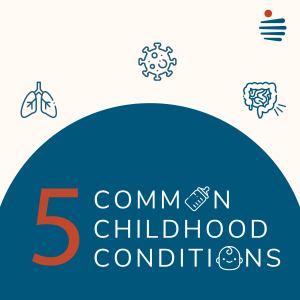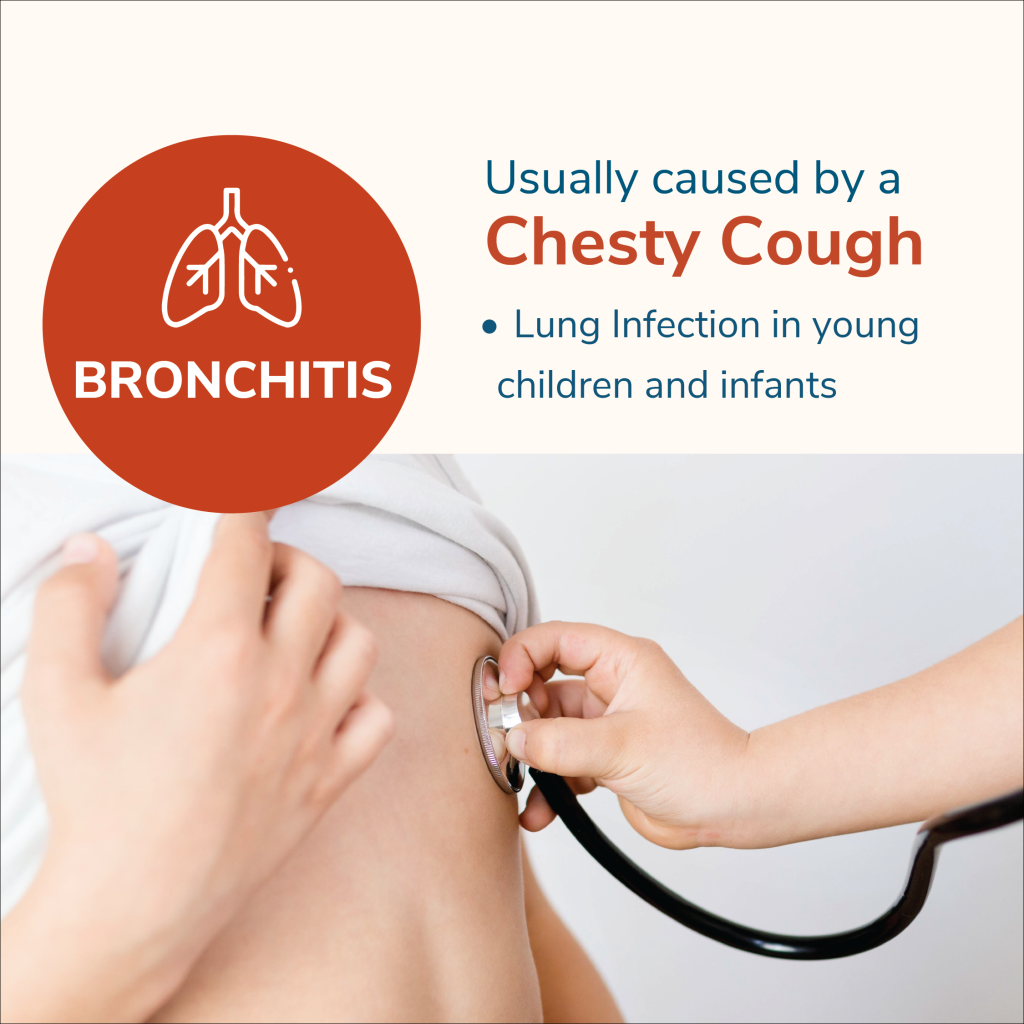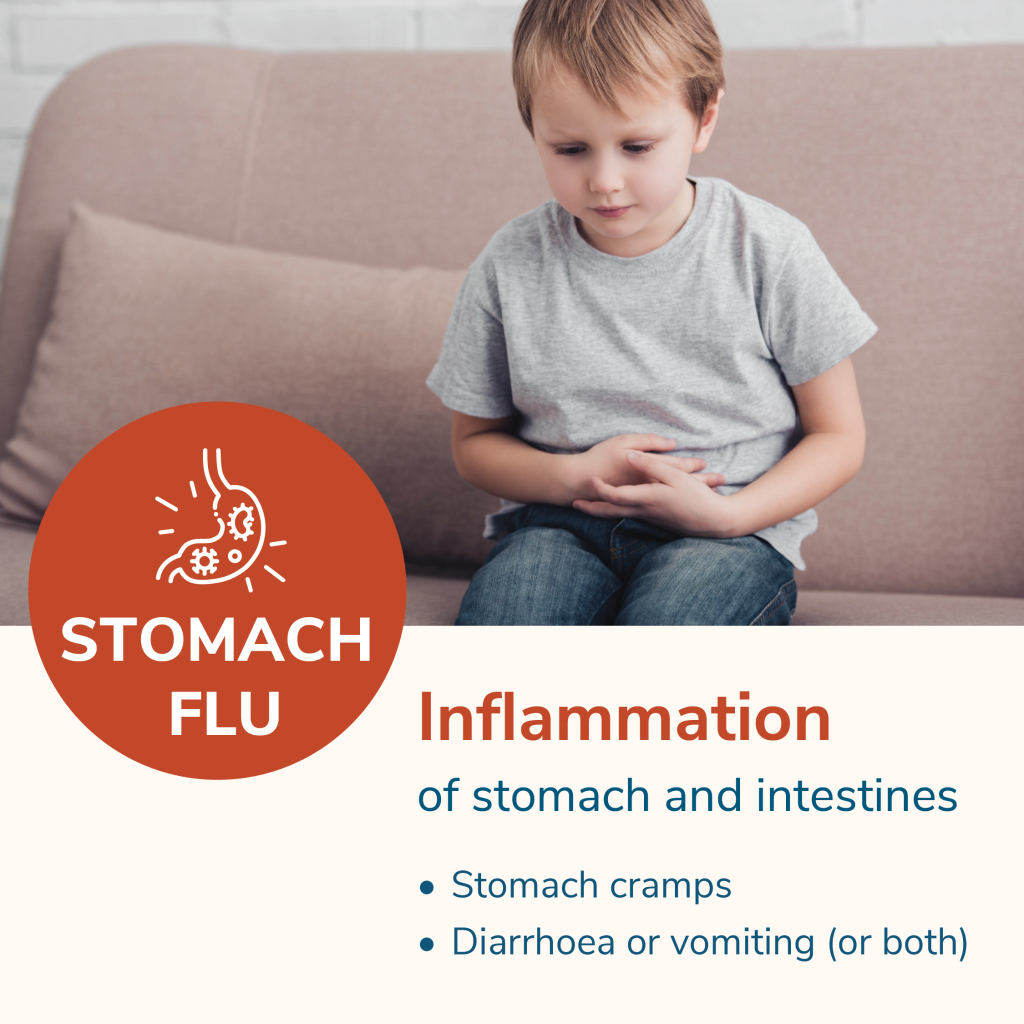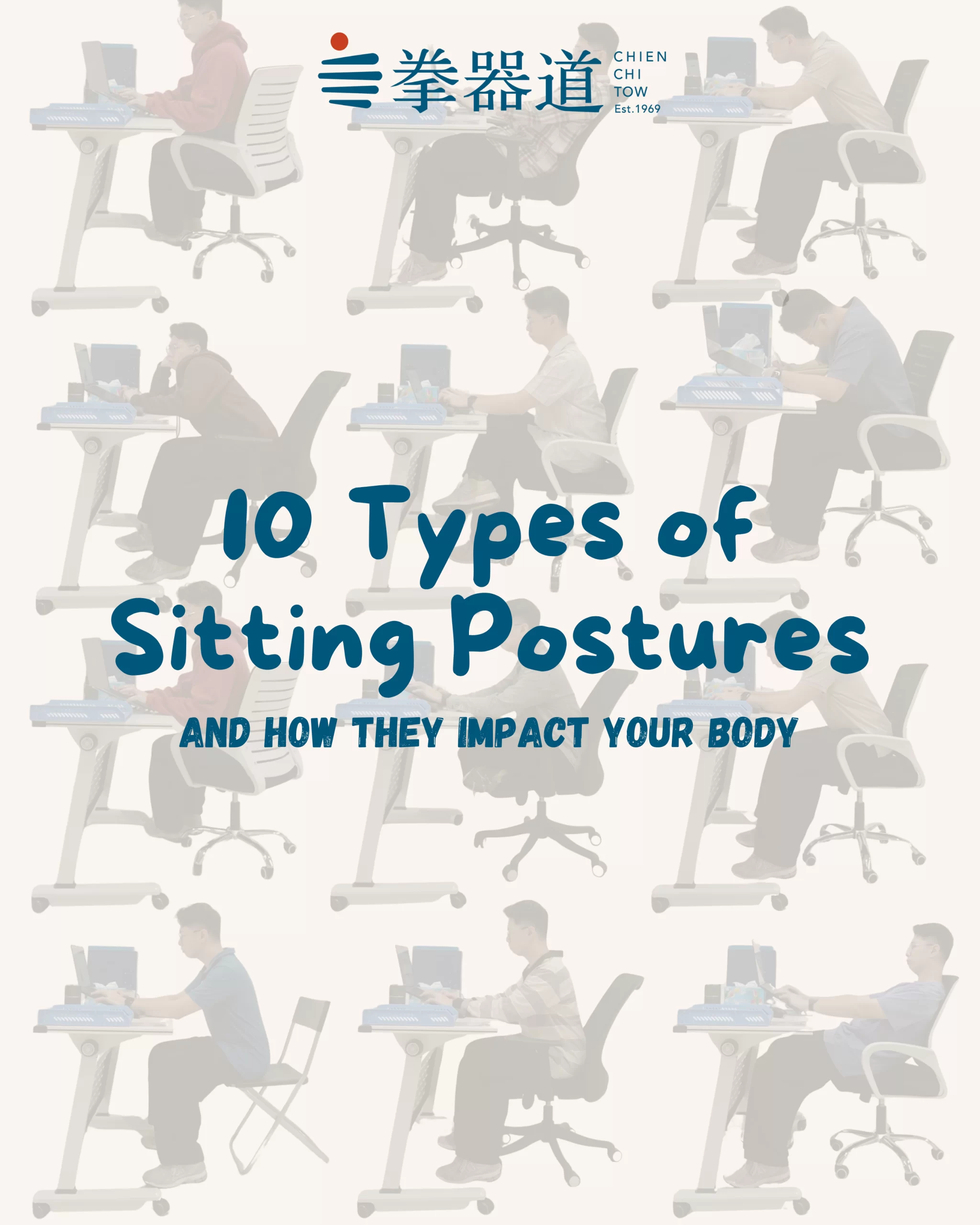What is Paediatric Tui Na?
Paediatric Tui Na is a therapeutic, gentle and non-invasive external therapy for children. It stimulates acupoints to enhance your child’s immune system, growth, overall well-being, and it is an effective modality to treat and prevent illness. Paediatric Tui Na is best for children under 6 years old because their acupoints are more pronounced and easily stimulated for immediate result in a shorter span of time.
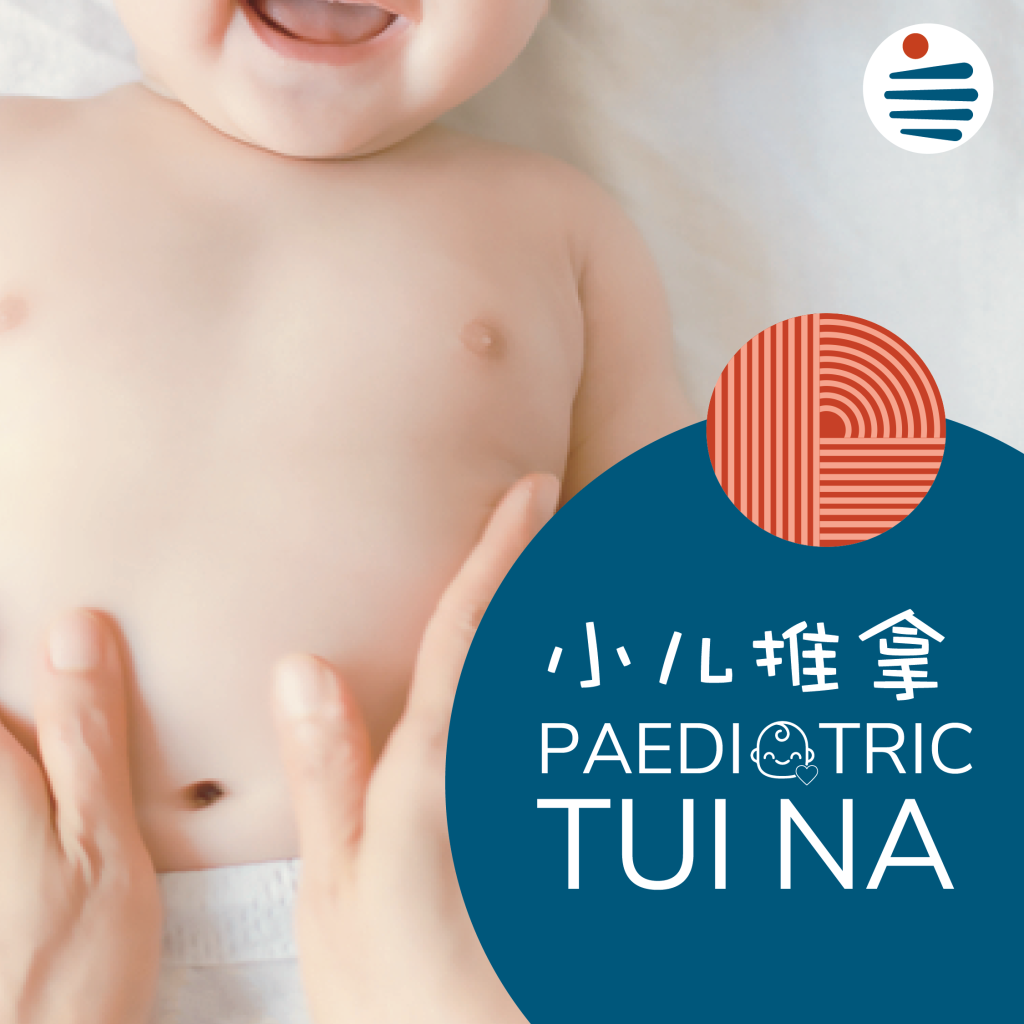
The duration of Paediatric Tui Na can vary according to the child’s age and condition. Each session is between 20-30 minutes for children under 3 years old and covers the head, face, stomach, back, legs and hands. The entire session is gentle and painless, and on point to provide effective results.
- Child Friendly
- Gentle & Non-Invasive
- Therapeutic
- Treat and Prevent Illness
- Support Growth and Overall Well-being
Top 5 Childhood Conditions
As parents, your priority is definitely the well-being of your child. Regulating a child’s organ functions through Paediatric Tui Na is both effective to build up the child’s natural immunity or to prevent common paediatric ailments to purge out pathogenic factors when the child is sick. Here are the Top 5 Common Childhood Conditions that Tui Na massages can help your child improve the condition. Find out if your child is experiencing the following symptoms and conditions.
Asthma
When Asthma attacks the child, the child’s airways become narrow and swell, which will make breathing difficult, and you can hear your child produce a wheezing or whistling sound. Some children will need medical treatment or use a quick-relief inhaler, nebulizer when suffering from an asthma attack.
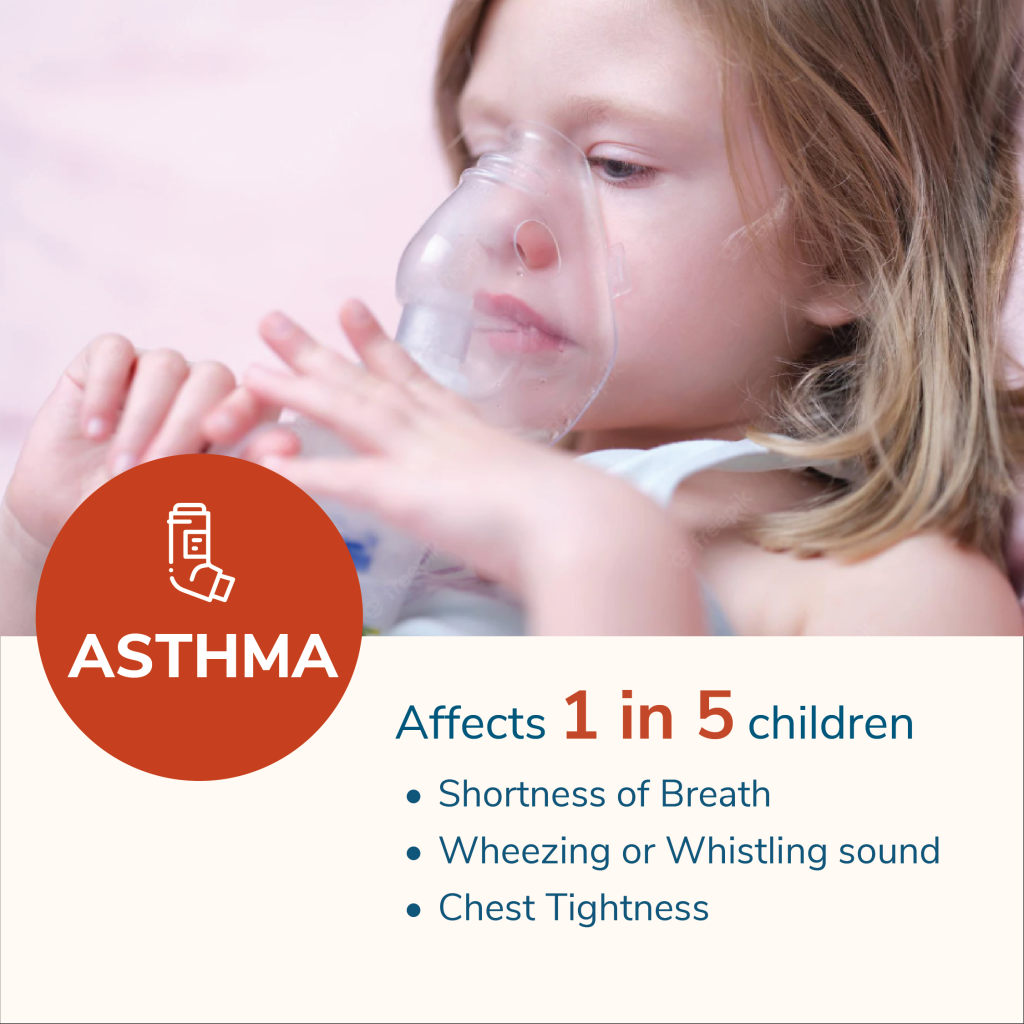
Did you know?
Did you know that Asthma affects about one in five children in Singapore? Child diagnosed with Asthma will be easily prone to respiratory diseases such as coughing which may lead to an Asthma attack any time. Hence, it is important to control the symptoms since this condition can be life-threatening too.
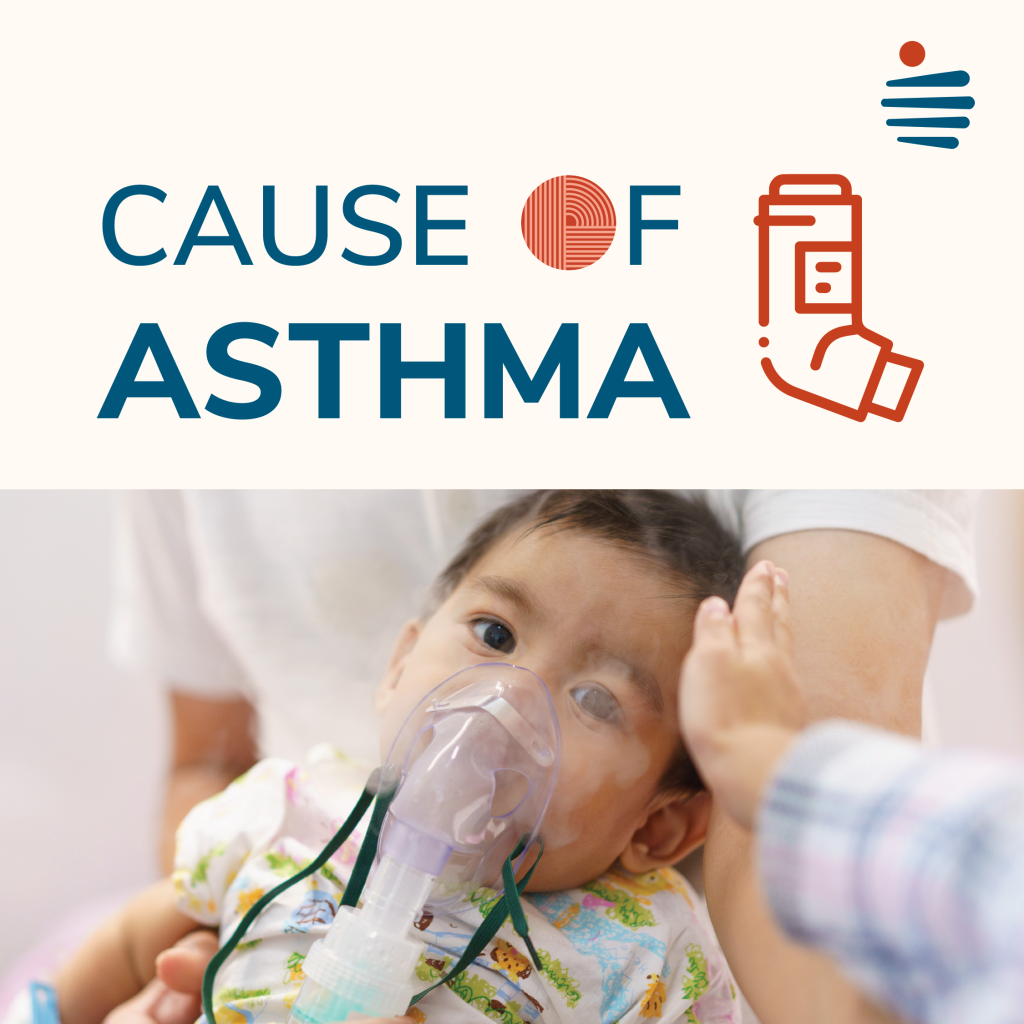
Causes of Asthma
A child developing asthma can be due to hereditary and environmental factors, which in TCM perspective we categorise them as inner cause and external cause.
Hereditary Asthma (Internal Cause)
The inner cause is mainly due to lung, spleen and kidney deficiency, which the body couldn’t have enough energy to remove the phlegm retention, hence, developing the root cause of asthma condition. If either parent has an asthma condition, you can pay more attention to your child’s symptoms to identify if your child is having an asthma condition and to seek treatment early.
Environment Factor (External Cause)
External cause is defined as the allergic reaction with the contact point of objects and bacteria. So parents tend to observe and take special note of what was passed to their child prior to the onset of the allergic reaction. Some of the most common causes of allergic reaction are dust mite, pollen, animal fur or feathers, fumes, pollution or airborne irritants.
4 Types of Asthma In TCM Perspective
In TCM’s perspective, 哮喘 is an asthmatic condition which causes difficulty in breathing. It is differentiated in 2 categories – Acute and Chronic asthma. Here’s the 4 most common body constitutions present in children that are affected by asthma.
Cold-Based Asthma (寒性哮喘)
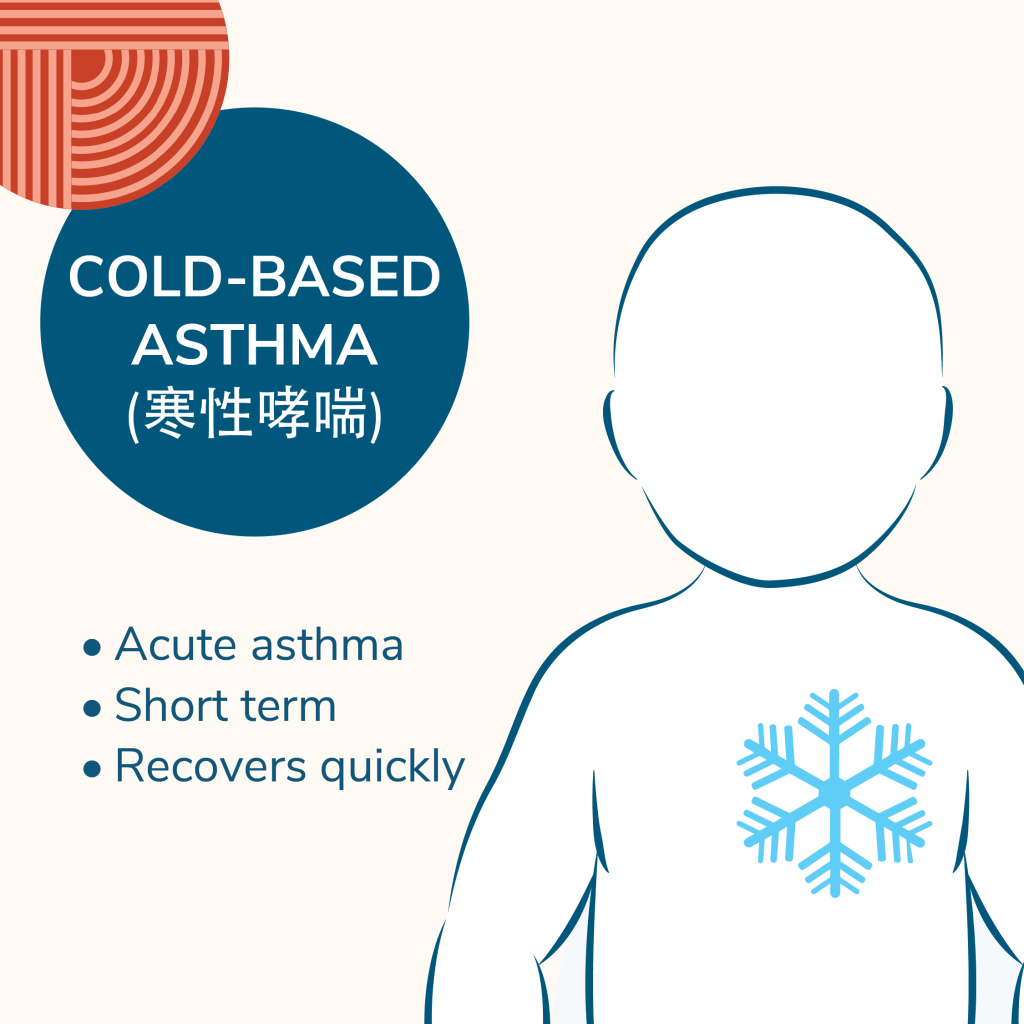
In TCM perspective, this belongs to acute 哮喘, which is usually short term and can be cured quickly.
Common Symptoms
- Watery Phlegm
- White Phlegm with Bubbles
- Cold Hands and Feet
- Pale Tongue with White Coating
Heat-Based Asthma (热性哮喘)
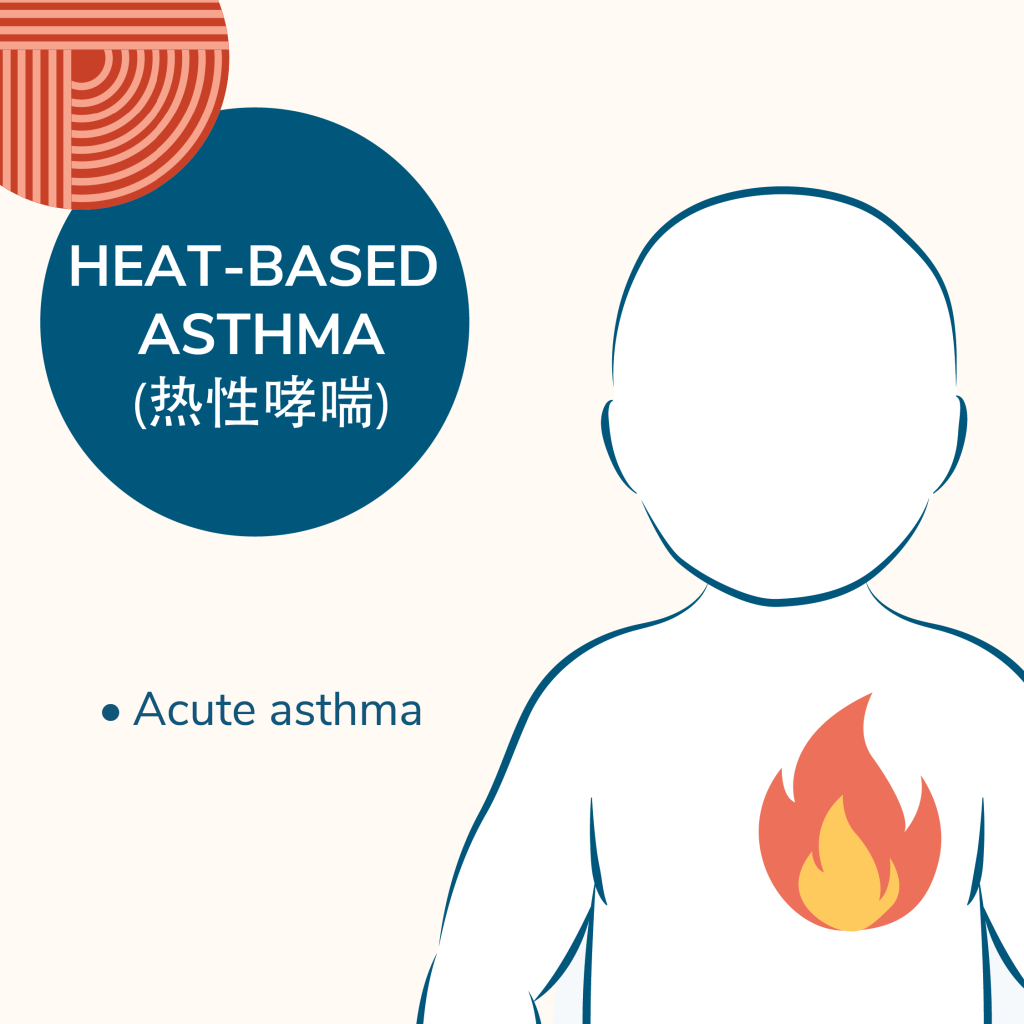
In TCM perspective, this is classified as acute asthma 哮喘 as well.
Common Symptoms
- Yellow and Sticky Phlegm
- Feeling Thirsty Easily
- Craving for Cold Drinks
- Frequent Perspiration
- Red Swollen Tongue with Yellow Coating
Kidney-Deficiency Asthma (肾虚哮喘)
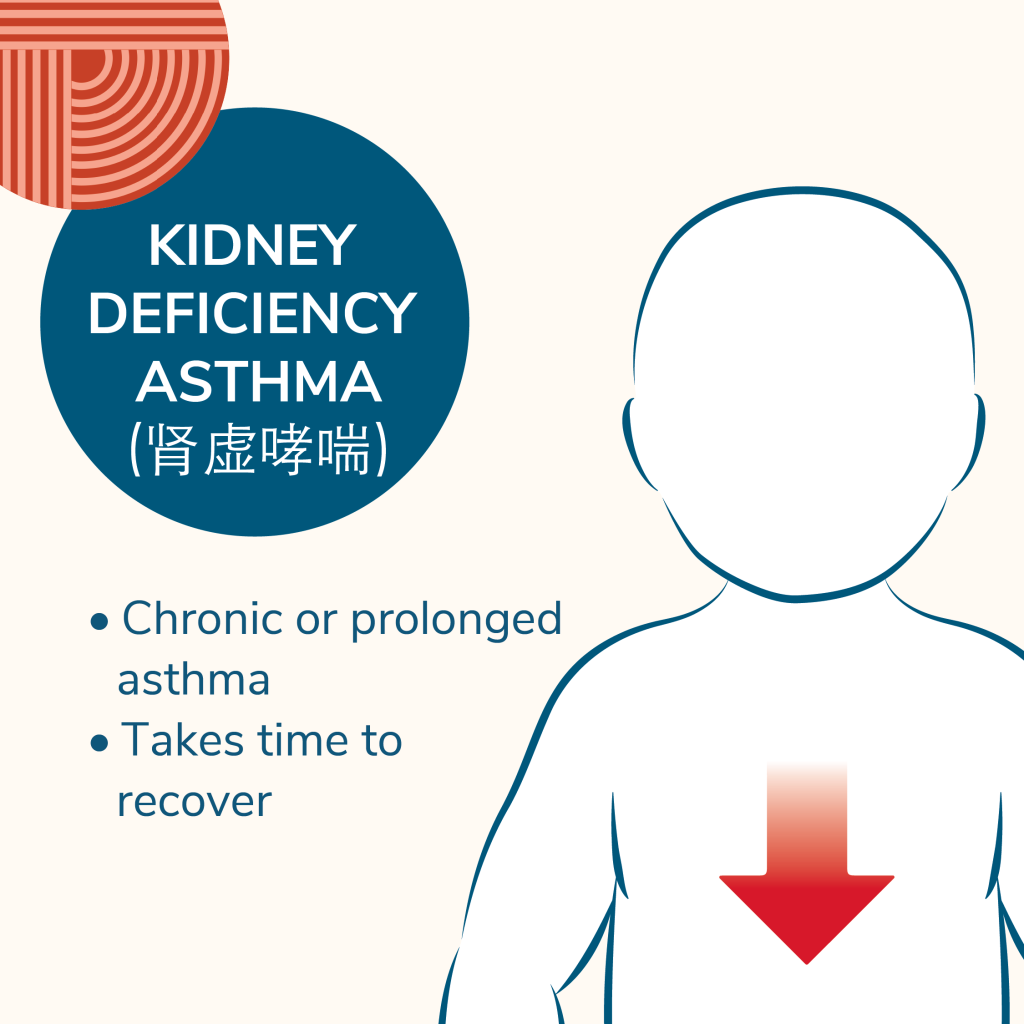
This is classified as chronic or prolonged asthma where it can take a longer duration to recover from that state. Also, improving such body constitution takes time and effort.
Common Symptoms
- Prolonged Asthma Conditions
- Irregular Breath (Short and Long Exhalation)
- Shortness of Breath with Physical Activities
Lung and Spleen-Deficiency Asthma (肺脾气虚哮喘)
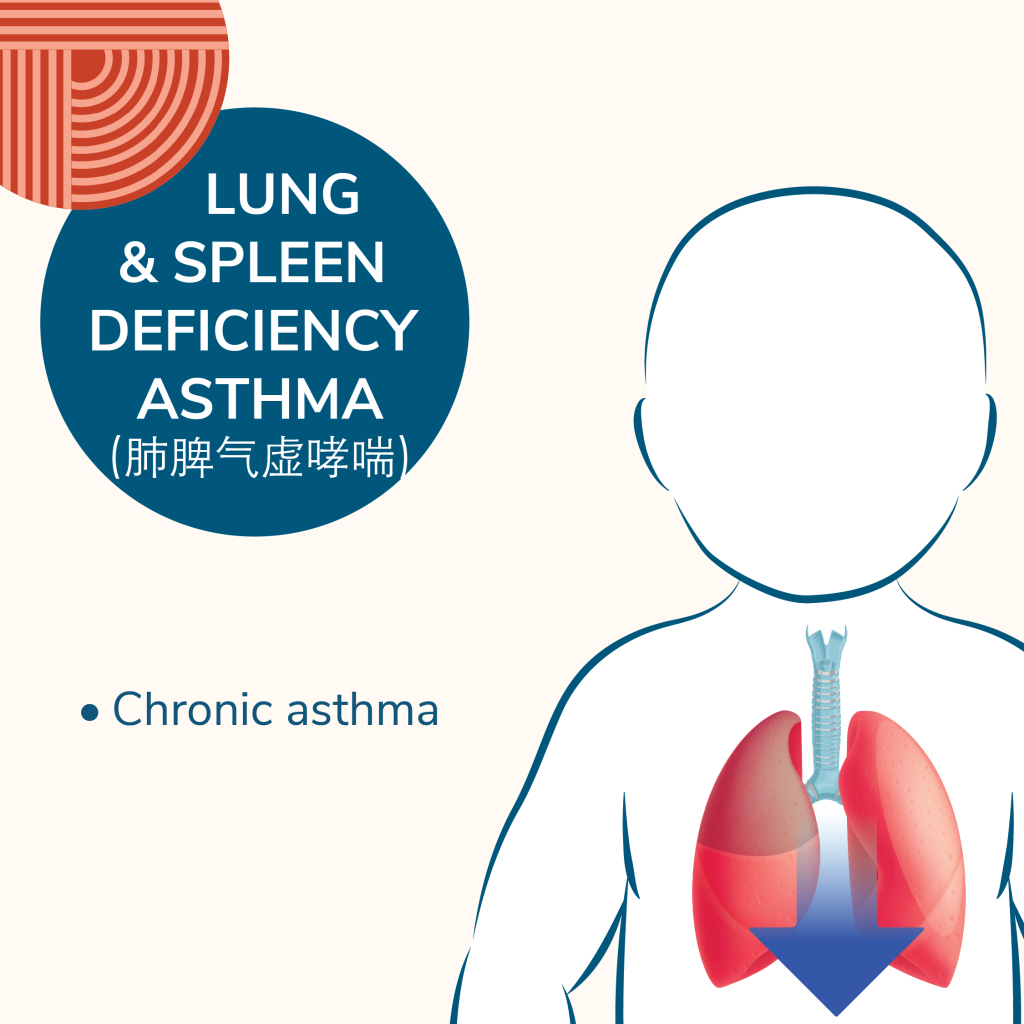
Similar to kidney deficiency asthma, this is also classified as chronic asthma.
Common Symptoms
- Shortness of Breath during Conversation
- Recurring Cold Condition
- Discomfort when Exposing to Wind
- Pale Tongue with White Coating
Home Remedies for Parents
In TCM’s perspective, Acupoints 天突 (Tian Tu) 定喘 (Ding Chuan) 肺腧 (Fei Shu) 搓摩肋胁 (Cuo Mo Le Xie) are beneficial to relieve the symptoms and speed up the body recovery.
天突 (Tian Tu)
Acupoint Location: 天突 is located above the midpoint above two collar bones and above the sternum (the T-Shaped vertical bone between your collar bone).
How to massage: You can sit your child up and face you for you to find the acupoint easier. Use your thumb tip to knead gently for 2 mins. Take note that you should only use light and gentle pressure to avoid causing your child to feel uncomfortable and airway being blocked.
Benefit: Regulate Qi, Reduce phlegm, Wheezing shortness of breath, Reduce cough
定喘 (Ding Chuan)
Acupoint Location: 定喘 is the two acupoints located at two sides of the most prominent bone at the bottom of the neck, connected to the back.
How to massage: Let your child lie face down. Use your index and middle finger to form a V to gently massage in an up-down motion for 2 minutes.
Benefit: Expel ‘wind’, relieve cold, soothe lung and wheezing shortness of breath
肺腧 (Fei Shu)
Acupoint Location: 肺腧 is below 定喘 (Ding Chuan), located in between the inner scapula and 3rd Spinous Process. It might be difficult to locate the exact point. So you can attempt to massage the area that will stimulate the acupoint.
How to massage: Use thumbs kneed in circular, up-down and left-right motion for 2 mins each
Benefit: Stop cough, reduce phlegm, nourish the lungs
搓摩肋胁 (Cuo Mo Le Xie)
How to massage: Make your child sit up front or back facing you. The area that you can massage is the side of your child’s rib cage, and the front and back of the rib cage.Use your 4 fingers to gently stroke and rub in circular, vertical up-down and horizontal motion for 2 mins each.
Benefit: Relieve and loosen muscles around the rib cage, increase lung capacity. Muscles tensed up when you cough, and your child will feel stuffy and restricted at the lung especially during breathing (胸闷)
Relief your child asthma symptom with TCM Paediatric Tui Na
Constipation
The constipation episode doesn’t just end here because some children may develop a phobia of pooping especially if the pooping ordeal is painful and tedious. Traces of blood in the poop could be visible too with excessive pushing which causes tears in the rectum. A constipated child exhibits symptoms such as a bloated stomach and loss of appetite too. And being constipated can also cause the child to be extremely fussy with flatulence build up causing a hard and bloated tummy.
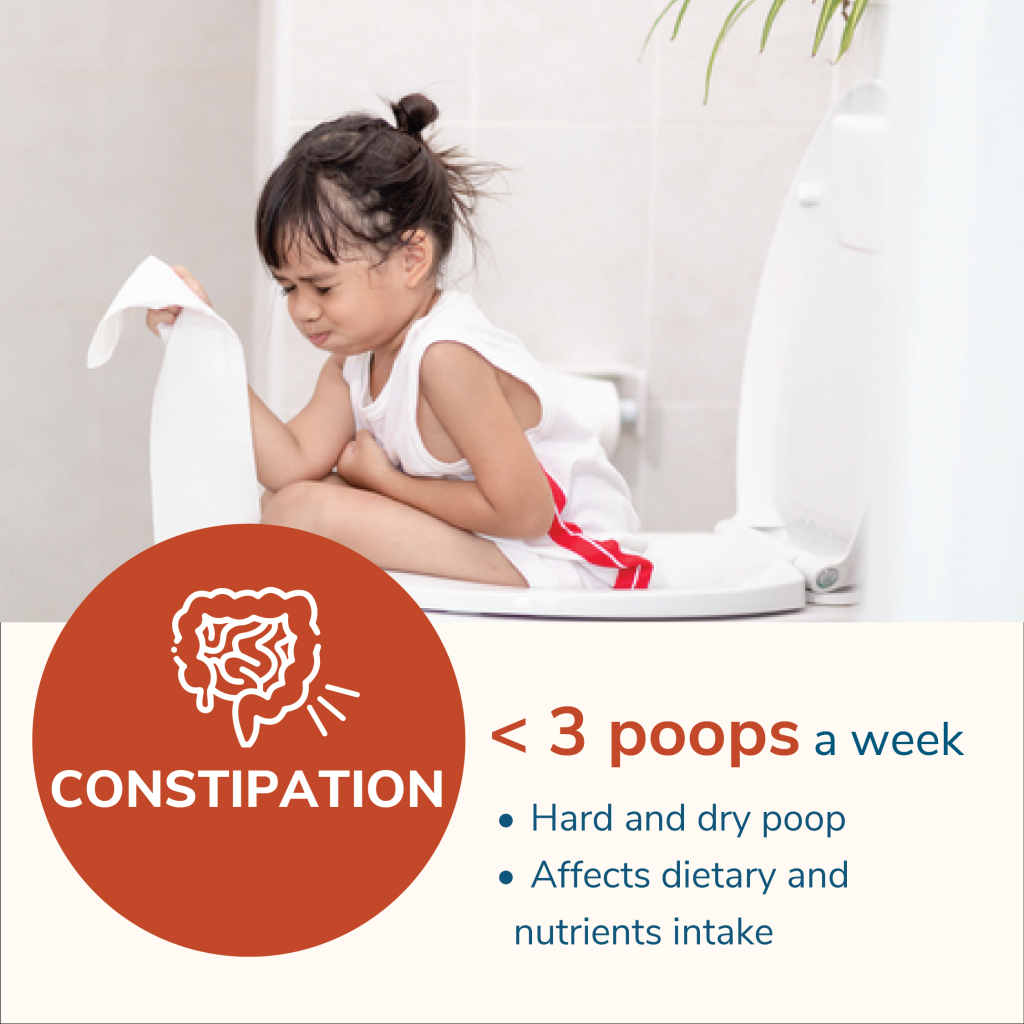
Did you know?
Your child’s bowel movement can tell you about their health condition. Does your child have less than 3 bowel movements in a week? Are the poops usually hard, dry and difficult to pass out? These are common signs of childhood constipation and are highly prevalent among children who don’t take in lots of fluids or fibre-rich food such as fruits and vegetables.
4 Types of Constipation in TCM Perspective
The cause of constipation can be affected by different factors such as dietary habits, emotion fluctuation and heatiness in body constitution. In TCM perspective, there are 4 common body constitutions present that are affected by Constipation.
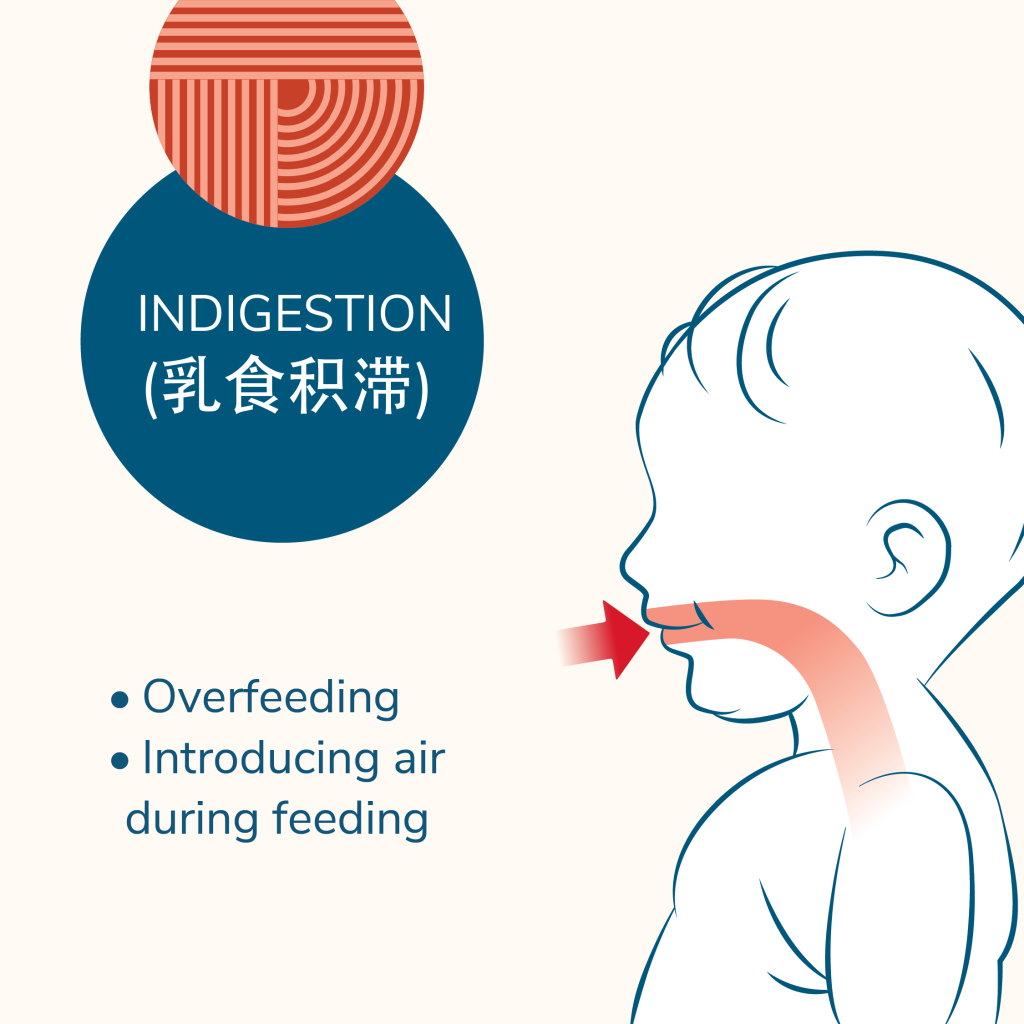
Feeding habits (乳食积滞)
Over feeding is one common habit that parents do, and alongside child’s Spleen Deficiency, it will be easy for add more stress on the spleen causing your child to experience constipation.
Another common feeding habit is the inclusion of air during feeding, such as vigorously shaking the milk bottle to mix the formula milk well with water. Though unintentional, it is still very common for such incidents to occur. This will cause your child’s stomach to bloat, adding more stress to your child’s stomach and spleen function leading to constipation.
Heatiness (邪热伤津)
It is common for children to be affected by the humidity and the ‘heaty’ environment in Singapore. In addition, highly processed fast food and sweetened treats can worsen the heatiness condition in your child’s body constitution. This will cause your child stools to harden and lead to constipation.
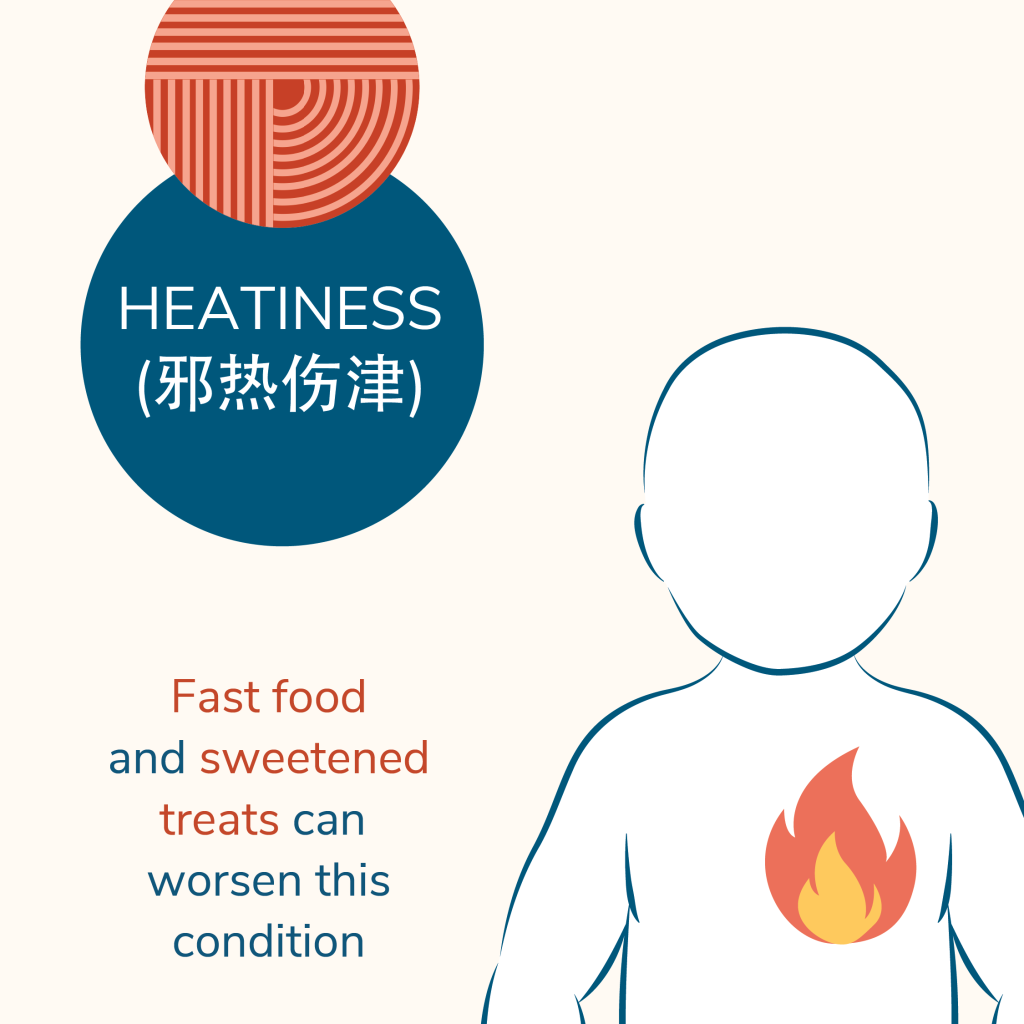
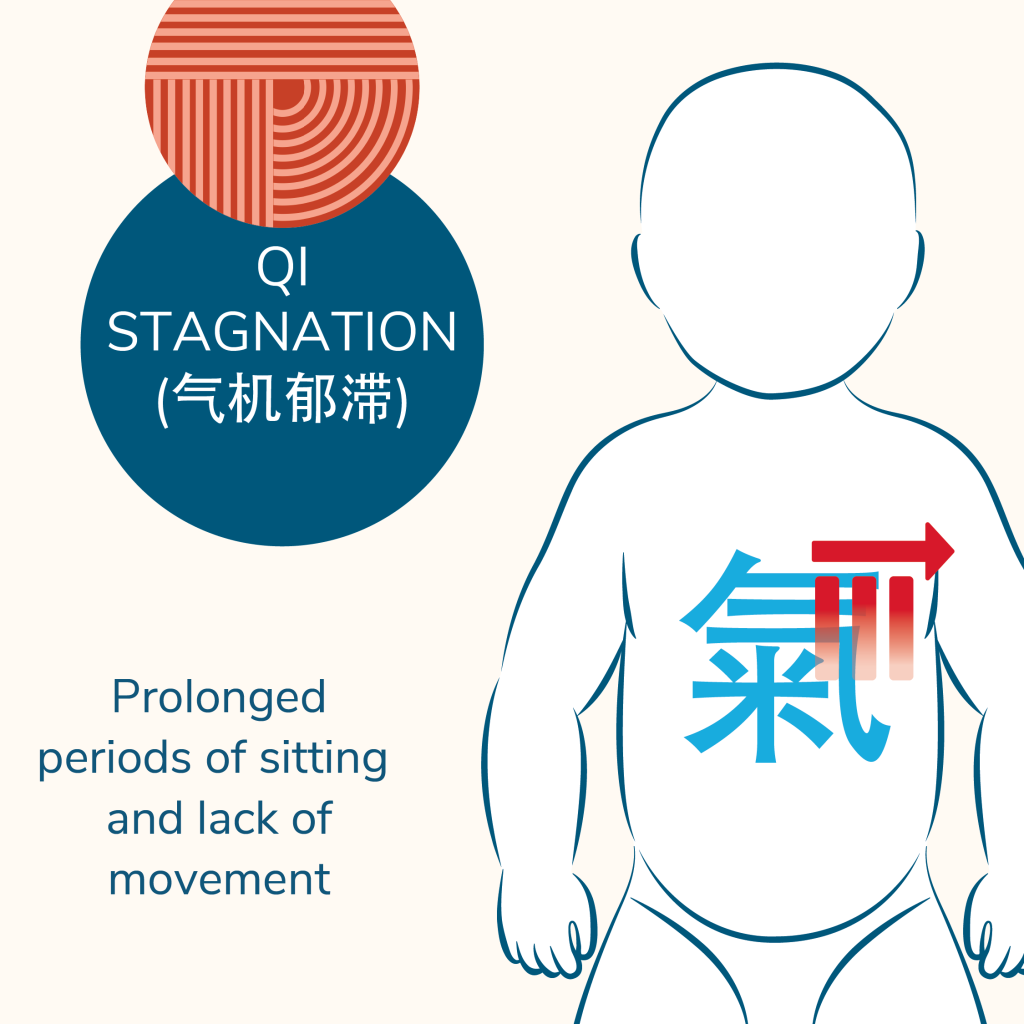
Qi Stagnation (气机郁滞)
This is usually affected by the child’s habit such as prolonged periods of sitting and lack of movement, affecting the bowel movement. Thereafter, causing constipation and the fear of pooping, which then lead to Qi Stagnation and worsening of the constipation condition.
Qi and Blood Deficiency (气血亏虚)
This can be due to the existing body constitution, medical issues or even consumption of medicine, causing a child to experience Qi and Blood deficiency. This will lead to the lack of energy and decrease of bowel movement causing constipation.
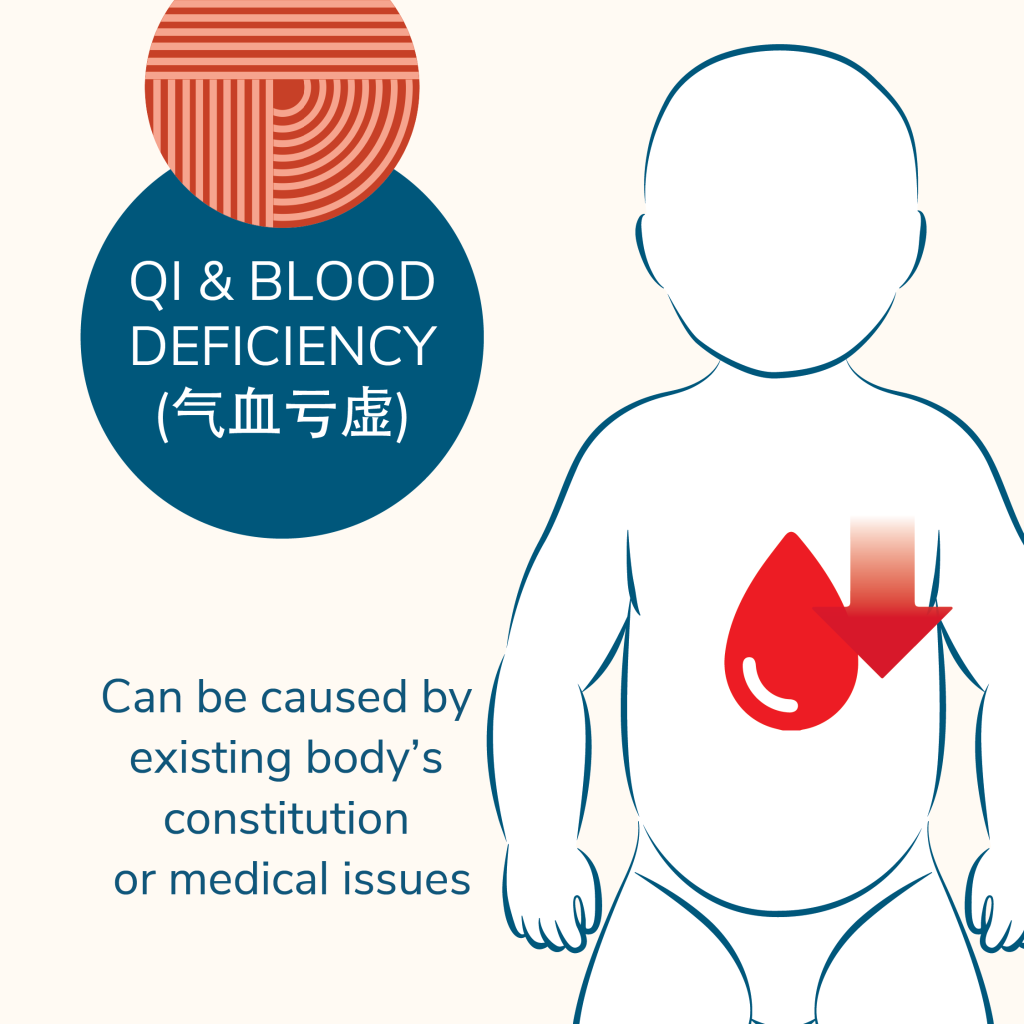
Home Remedies for Parents
膊阳池 (Bo Yang Chi)
Acupoint Location: With the palm facing down, 膊阳池 (Bo Yang Chi) is located at the 3 fingers* away from the wrist and midpoint of the forearm. *Do note to use your child’s finger as a measurement.
How to massage: Use the thumb tip to rub gently clockwise and anticlockwise for 2 mins each.
Benefit: Improve bowel movement
七节骨 (Qi Jie Gu) & 龟尾 (Gui Wei)
Acupoint Location: 七节骨 at the centre line of the body, between the waistline to the start of the tailbone which known as 龟尾. 龟尾 is located at the top of the folding part of the buttock.
How to massage: Make the child face down. Use 3 fingers to massage in left-right motion at the 七节骨 for 1,5 minutes. Use the thumb tip to rub gently on 龟尾 in circular motion for 1.5mins.
Alternatively, you can also massage both 七节骨 (Qi Jie Gu) & 龟尾 (Gui Wei) together.
Benefit: Regulate bowel movement and improve large intestine
TCM Paediatric Tui Na for your child
Eczema
Eczema, known as Atopic dermatitis, or a condition characterised by dry, itchy and inflamed skin that can occur at any age. The itch sensation from eczema can be very irritating although it is not contagious. It is hereditary too if either parent has a history of eczema.
Besides monitoring the irritants or allergens, environmental factors play a part too such as cold, dry or high dampness weather. In TCM’s perspective, childhood eczema is likely caused by Spleen & Stomach deficiency and Dampness in the child’s body. The spleen & stomach deficiency causes dysfunction in the entire body and results in stagnation with symptoms of rash or flaky skin.
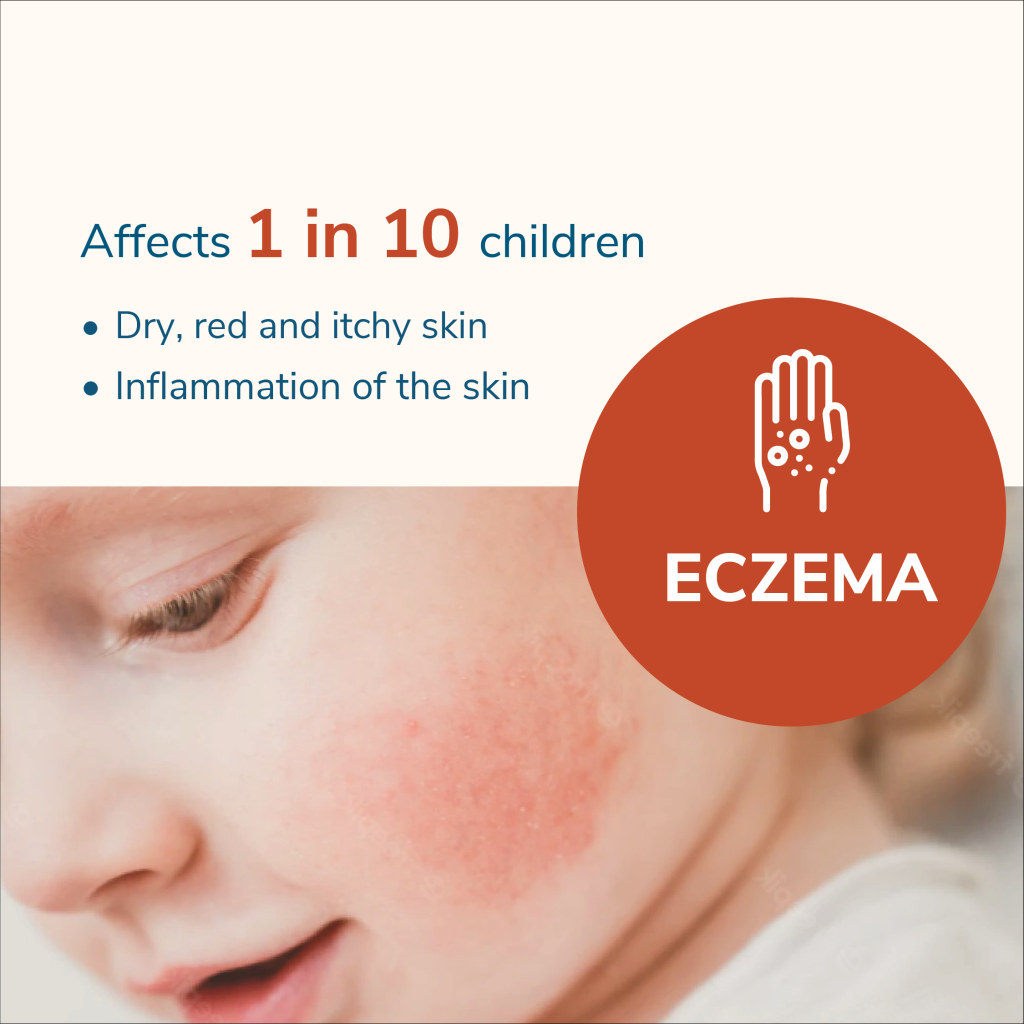
Did you know?
Parents are recommended to avoid regular washing of the affected area, and avoid using soap as it will remove the body natural oil protection
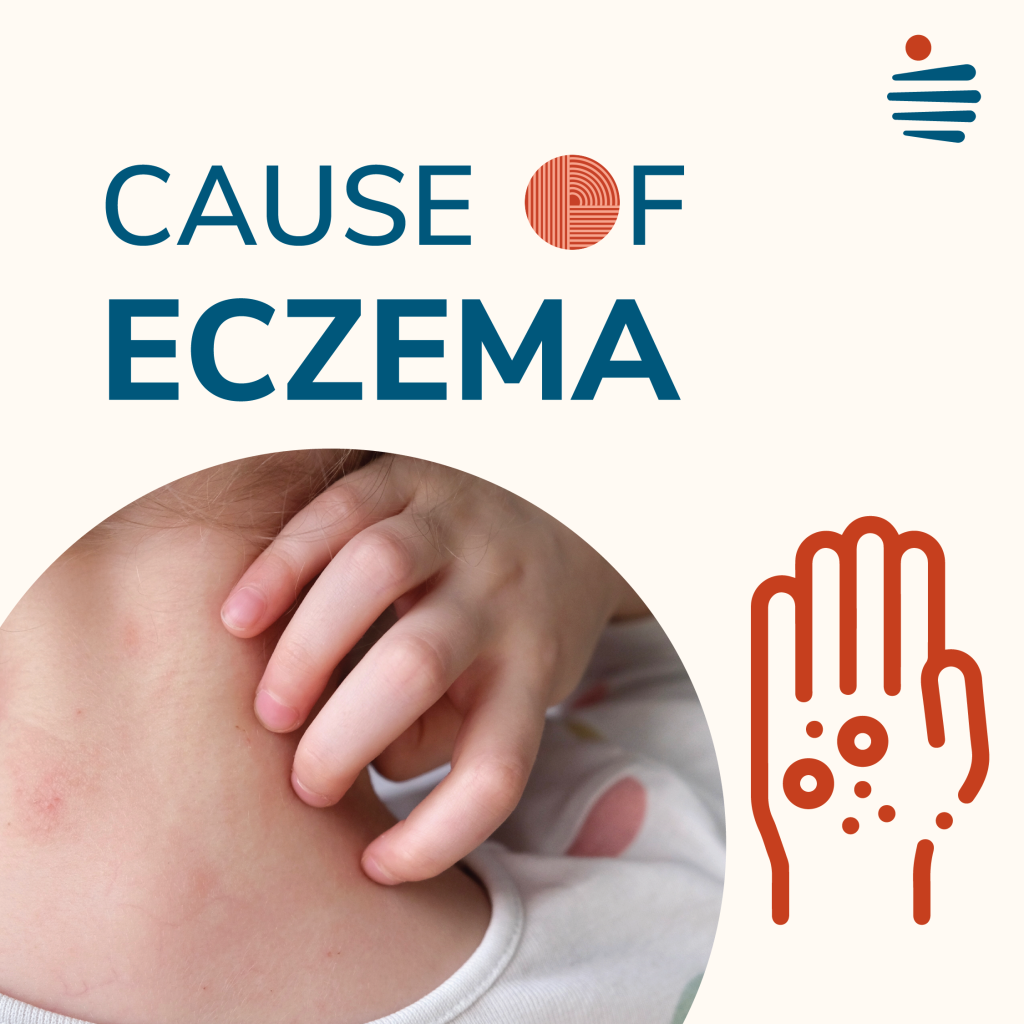
Causes of Eczema
The cause of eczema in TCM perspective, can be linked to different types of body constitution such as spleen and blood deficiency, or even having a damp and heaty body constitution which can cause your child to develop eczema in a hot and humid environment like Singapore.
External Environment Cause
External cause of eczema is due to the allergic reaction to the food your child intake such as cow’s milk products and peanuts. This can be identified with the removal of certain food in your child’s diet to observe if the condition improves. External environment such as dust, pollutants, cold and dry weather play may worsen eczema condition too.
3 Types of Eczema In TCM Perspective
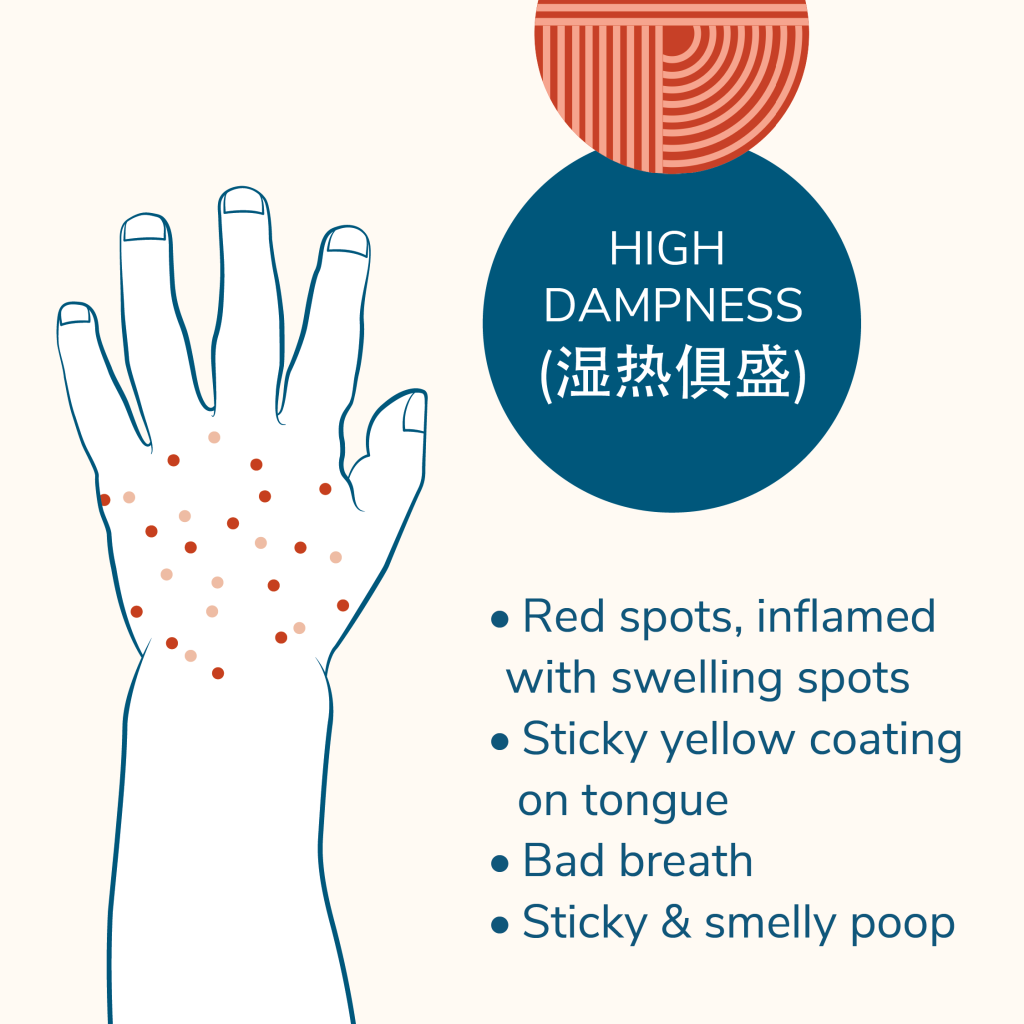
High Dampness Based (湿热俱盛)
- Red spots, inflamed with swelling spots
- Bad breath
- Sticky and smelly poop
- Sticky yellow coating on tongue
Spleen Deficiency Based (脾虚湿盛)
- Dark red skin and may have blister
- Bloated stomach
- Loose poop
- Pale tongue with white coating
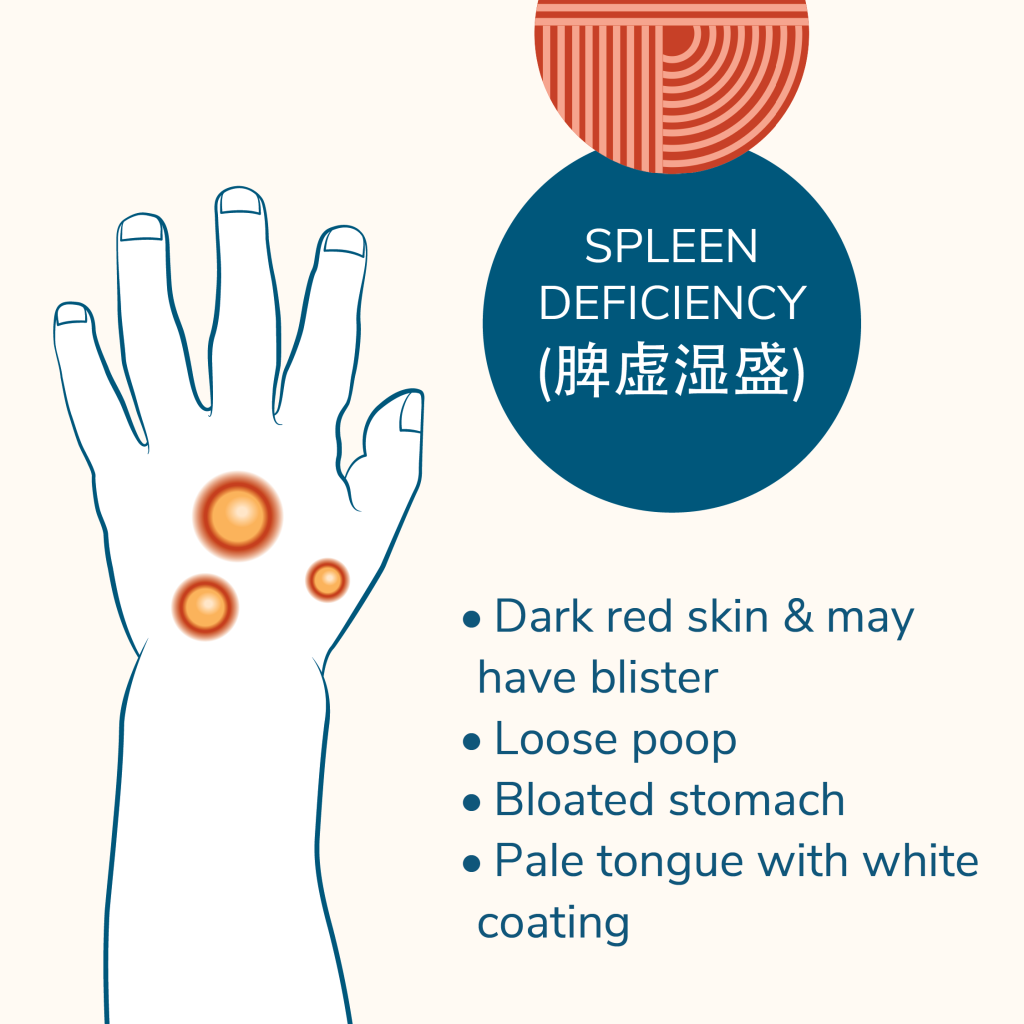
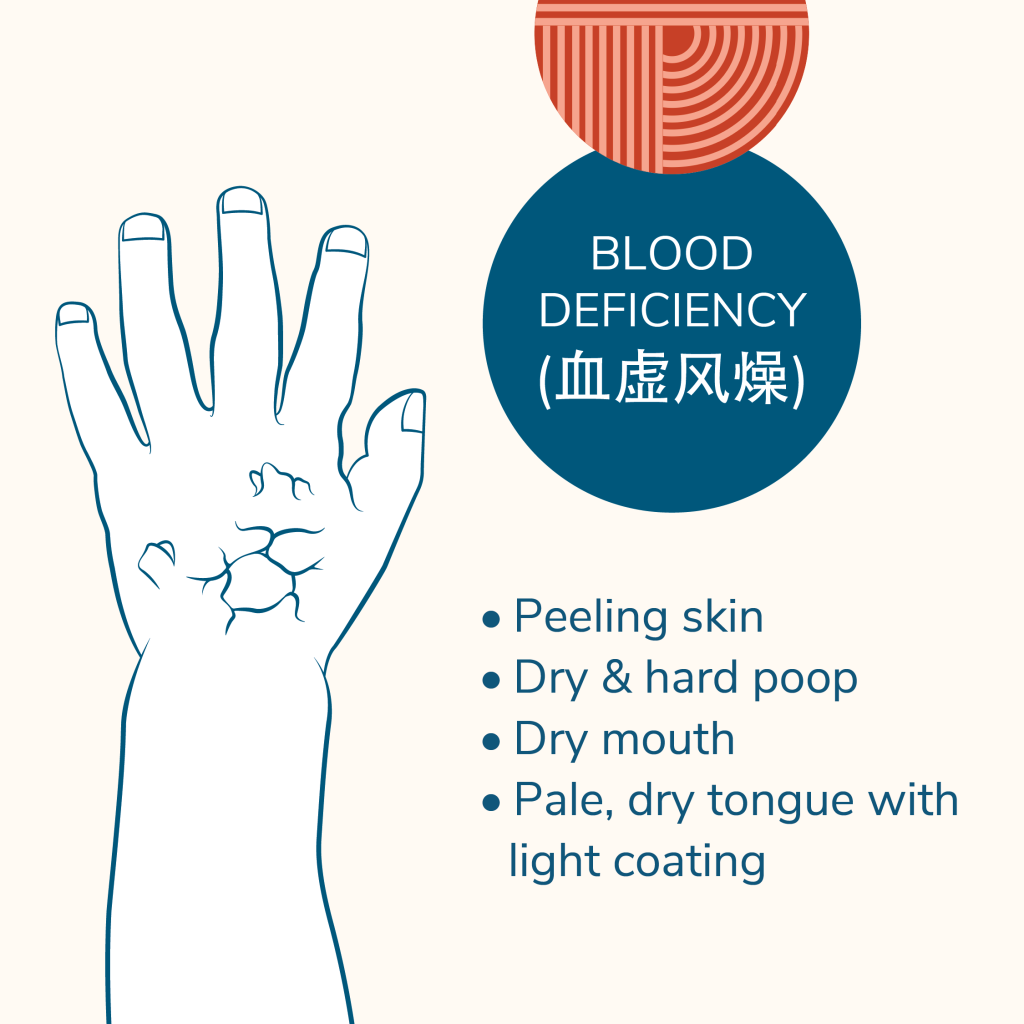
Blood Deficiency Based (血虚风燥)
- Peeling skin
- Dry and hard poop
- Dry mouth
- Pale, dry tongue with light coating
Home Remedies for Parents
血海 (Xue Hai)
Acupoint Location: Get your child to bend their knee. 血海 is located 2 fingers distance from knee.
How to massage: Use the thumb tip to rub gently clockwise and anticlockwise.
Benefit: Improve your blood circulation, expel dampness
箕门 (Ji Men)
Acupoint Location: 箕门 is the area from inner thigh to the groin area.
How to massage: Using 2 fingers to rub gently from the inner thigh to the groin area in up-down motion
Benefit: Improve spleen and reduce dampness in the body. Expel heatiness and improve urination.
Consult our TCM Physicians on your child's condition.
Stomach Flu
Known as gastroenteritis, it is an viral infection at the intestine and common symptoms such as stomach pain, loose stools, vomiting or fever may manifest after 1-2 days.
Furthermore, children with diagnosed stomach flu will have either frequent vomiting or diarrhea and there will be a risk of fluid loss from the body. It is important to keep your child hydrated with sips of water whenever possible. Avoid food such as dairy because the body is unable to digest lactose in the milk and may worsen stomach pain and diarrhea too.
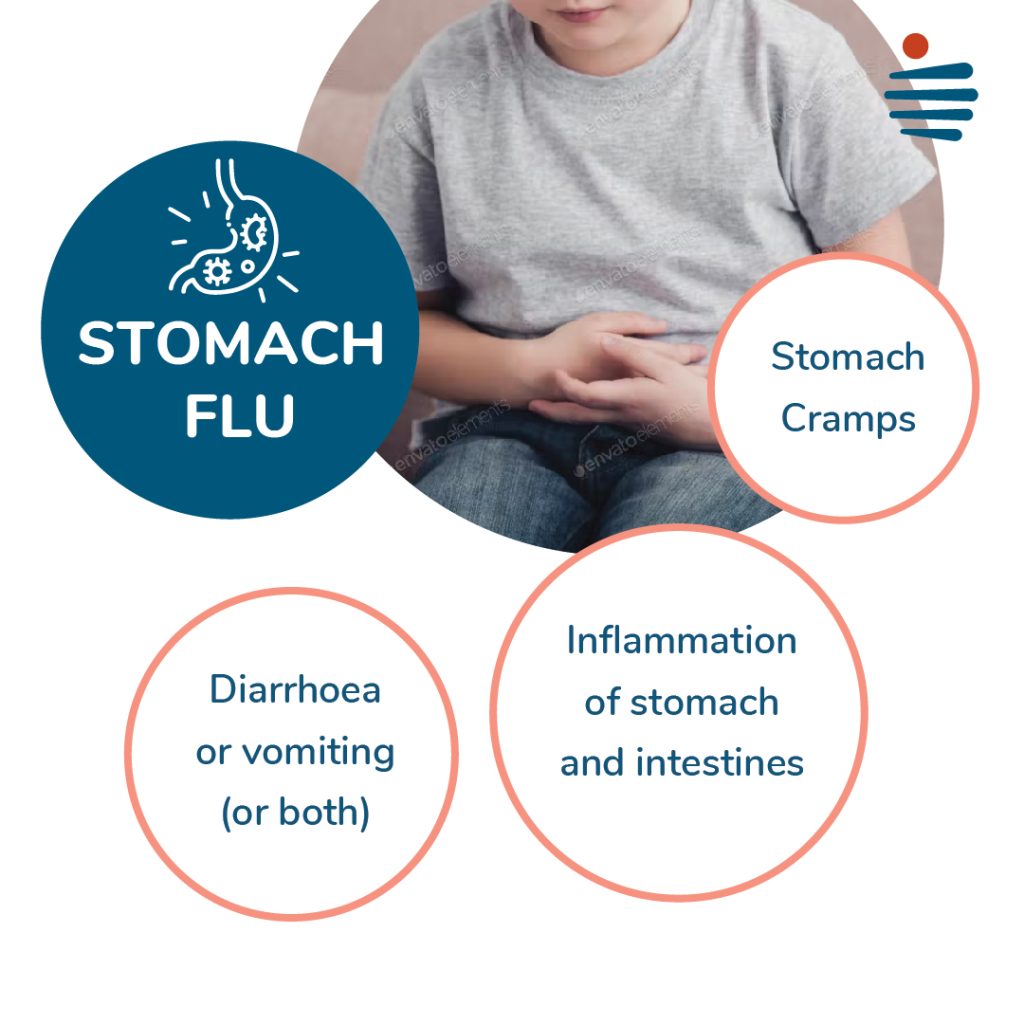
Did you know?
The cause of infection is usually unknown and it is very contagious, hence, it is best to keep your child at home or separated from others, especially if you have young or elderly at home, as soon as symptoms have manifested.
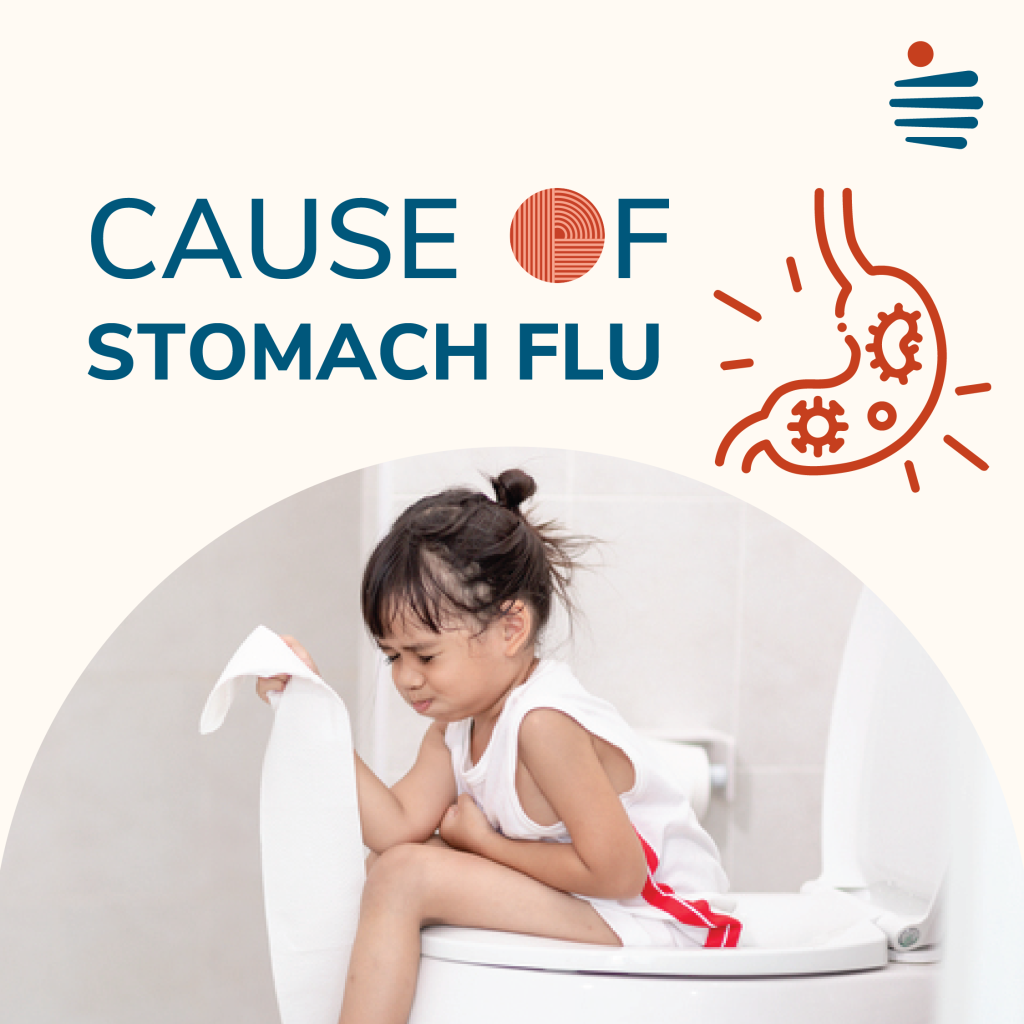
Cause of Stomach Flu
The main causes of stomach flu are categorized into 2 reasons, first being bacteria infection and the other will be the sensitivity of your child’s stomach and digestive system.
Bacteria Infection
Bacteria infection will usually be caused by bacteria and viruses which affect the gastrointestinal tract.
Stomach & Digestive System
Some children may have high sensitivity of the stomach and digestive system that easily cause their stomach to feel unwell. As your child might have issues with certain formula milk, or food within the diet plan, hence, it’s best to ensure you know the changes for each meal to identify the allergy of your child.
2 Types of Stomach Flu In TCM Perspective
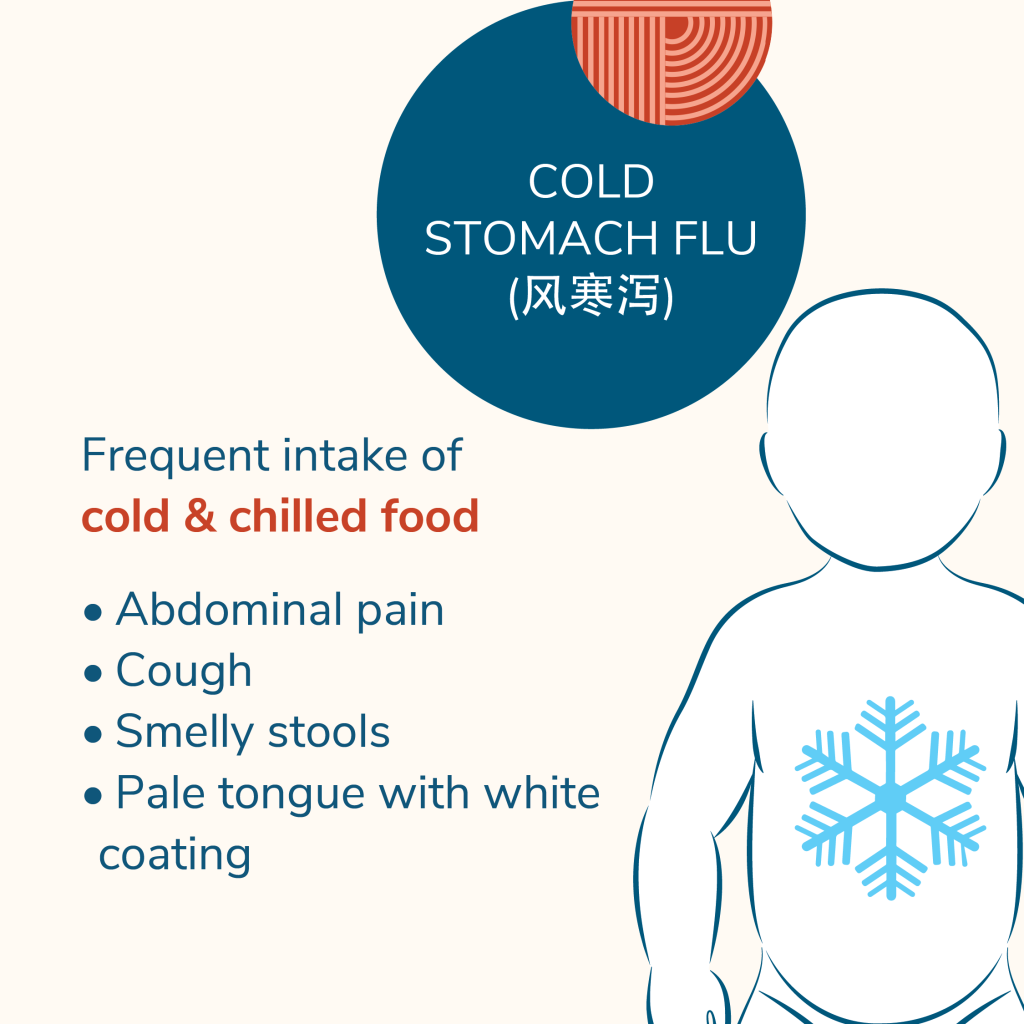
Cold Stomach Flu (风寒泻)
This is due to the vulnerability of your child’s stomach and frequent intake of cold and chilled food. The ‘Cold’ will affect the Stomach Qi flow causing the inverse flow of gastric gas leading to your child vomiting
- Smelly Stools
- Abdominal Pain
- Cough
- Pale Tongue with white coating
Heaty Stomach Flu (湿热泻)
Consuming heaty and spicy food, including breastfeeding mothers eating spicy and stimulating food can affect your child’s stomach to feel the heat from the spices through breast milk and food. The heatiness will also affect the Stomach Qi flow causing the inverse flow of gastric gas
- Watery stools
- Recurring diarrhea
- Lost of appetite
- Lack of energy
- Feeling thirsty
- Red Tongue with yellow coating
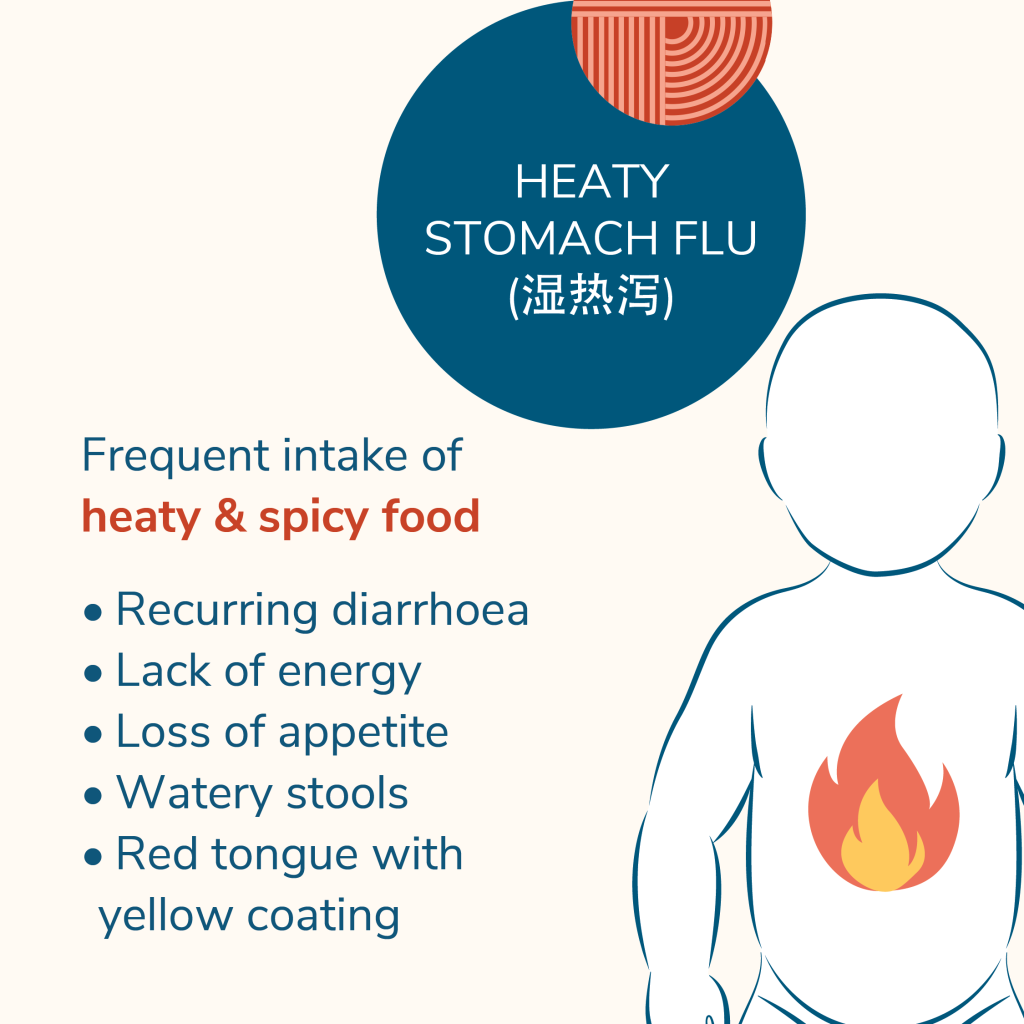
Home Remedies for Parents
中脘 (Zhong Wan)
Acupoint Location: Have you child lie down and face upward. The 中脘 is located at the midpoint between the lower end of chest bone and belly button.
How to massage: Use 2 fingers to rub gently clockwise and anticlockwise 2 mins each. The massaging motion will also stimulate stomach movement to improve digestion and also the small intestine to improve nutrients absorption.
Benefit: Improve spleen function, soothing stomach, improve digestion, reduce bloatedness, vomiting, diarrhea, stomachache
板门 (Ban Men)
Acupoint Location: Have your child’s palm face upward. 板门 (Ban Men) is located at the thickest part of the base of the thumb.
How to massage: Use the thumb tip to rub gently clockwise and anticlockwise for 1 mins each.
Benefit: Expel heatiness, improve digestion, Reduce bloatedness, relieve cough and diarrhea
Relief your child asthma symptom with TCM Paediatric Tui Na
Bronchitis and Bronchiolitis (Prolonged Coughing)
Bronchitis or bronchiolitis are also known as the infection at the lung and it is highly prevalent amongst children under 12 years old. Bronchitis is a medical condition where the bronchi is inflamed and swelling. Vice versa, Bronchioitis is an inflammation and swelling of the bronchioles. Most children may need to stay in the hospital for up to a week to ensure a complete recovery and some children may require immediate treatments in the hospital.
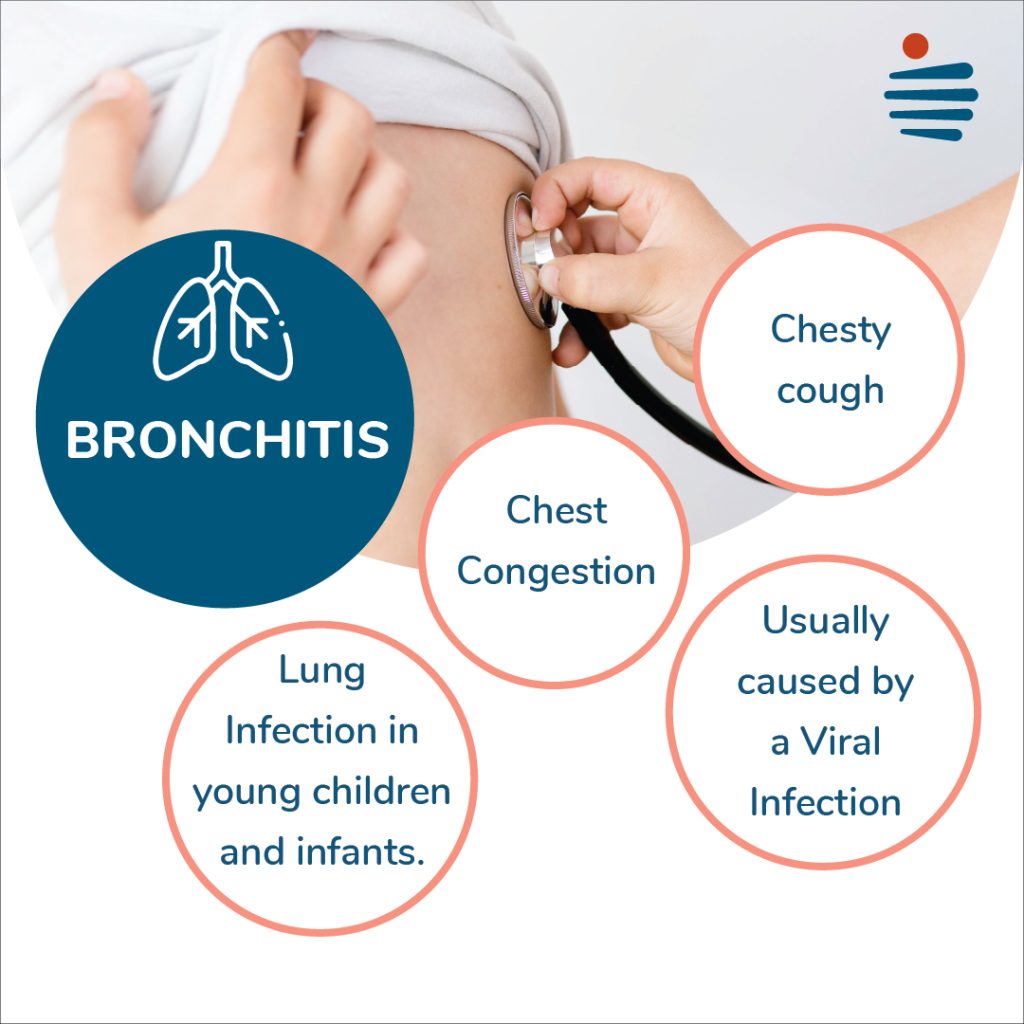
Did you know?
Did you know that prolonged phlegm or chesty cough is not good for your child? Although these are the initial symptoms of a common cold, the condition may escalate to Bronchitis or Bronchiolitis with more visible discomfort such as shortness of breath or wheezing sound, if the child didn’t fight off with the virus successfully.
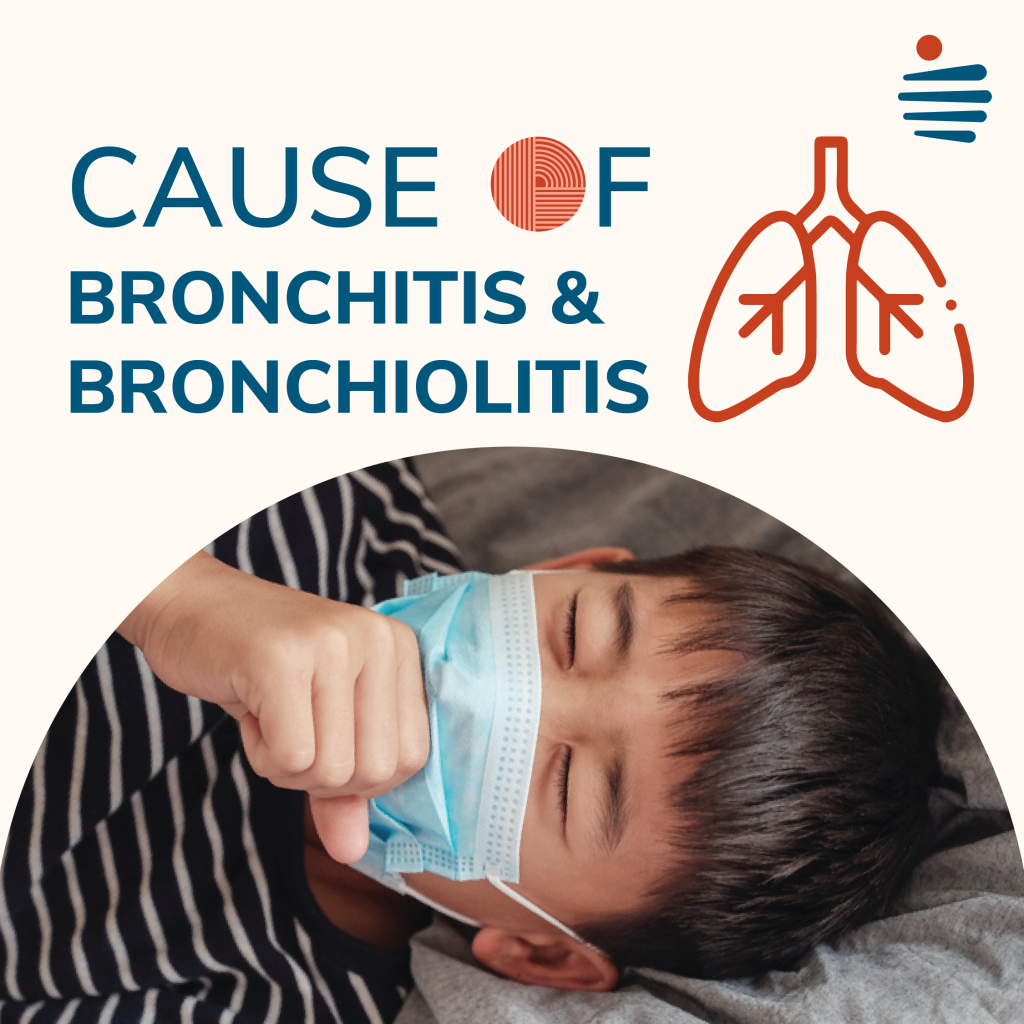
Cause of Bronchitis and Bronchiolitis
Bronchitis and Bronchiolitis in TCM perspective are conditions caused by prolonged coughing, and in terms of coughing, there are different causes of coughing. Coughing can be caused by respiratory infection, lack of nutrients and/or immunity.
Lungs Qi (肺气) helps to expel 外邪 (external ‘evil’ Qi that affect the Qi flow within your lungs) out of your body, to prevent coughing due to irregulate Qi in your lungs. It also helps to regulate moisture out from your lungs to prevent phlegm from forming.
3 Types of Coughing in TCM Perspective
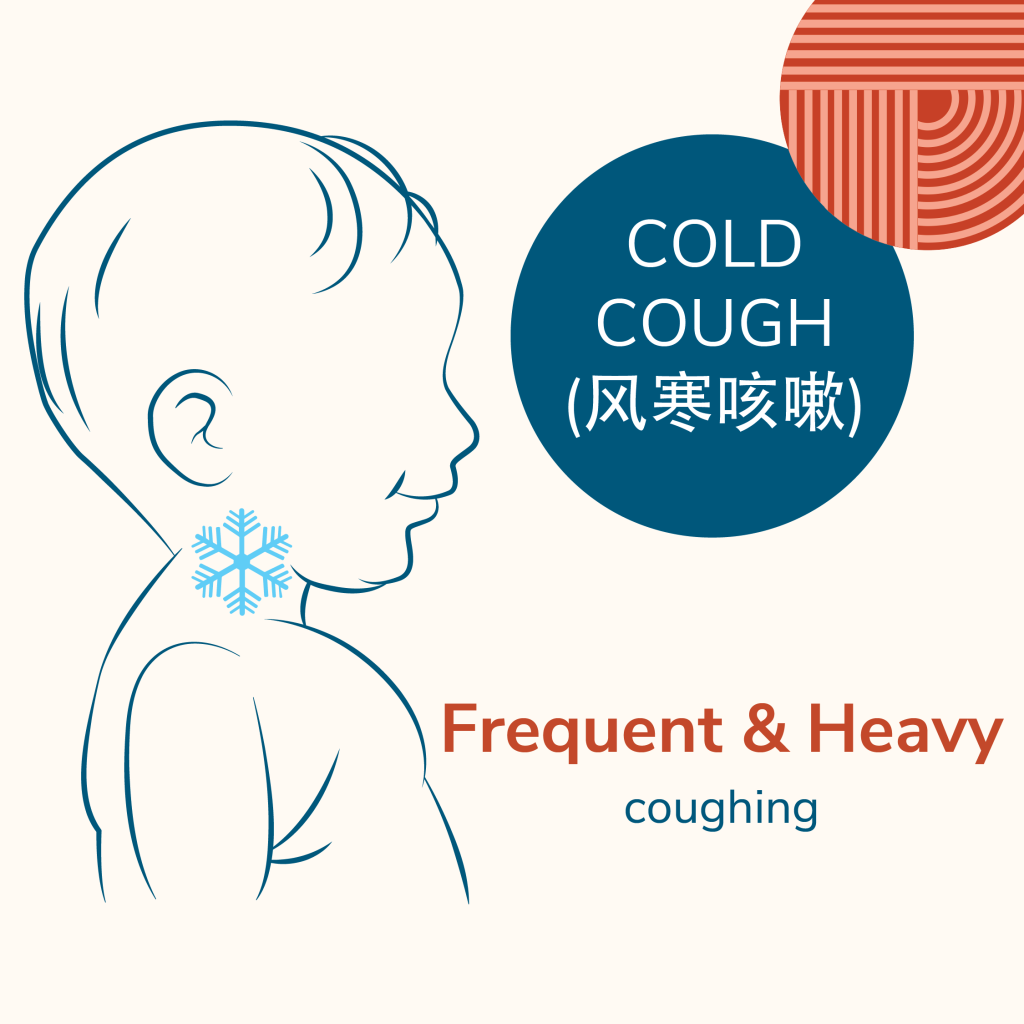
Cold Cough (风寒咳嗽)
- Frequent and heavy cough
- White and translucent phlegm and nasal discharge
- Warm body temperature but lacking in perspiration
- Red tongue with white coating
Heatiness Cough (风热咳嗽)
- Itchy throat with coughing
- Yellow and sticky phlegm and nasal discharge
- Frequent Thirst
- Perspiration around forehead and neck area
- Red tongue with yellow coating
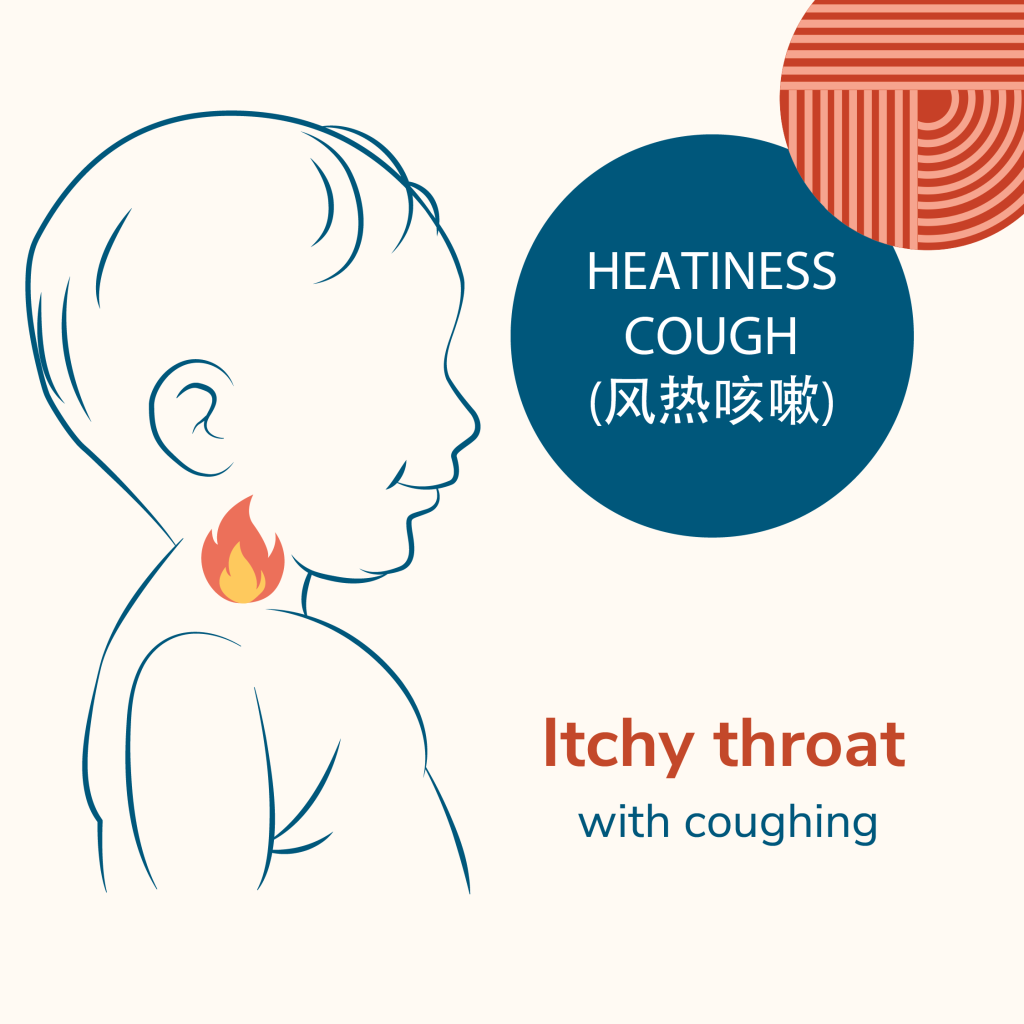
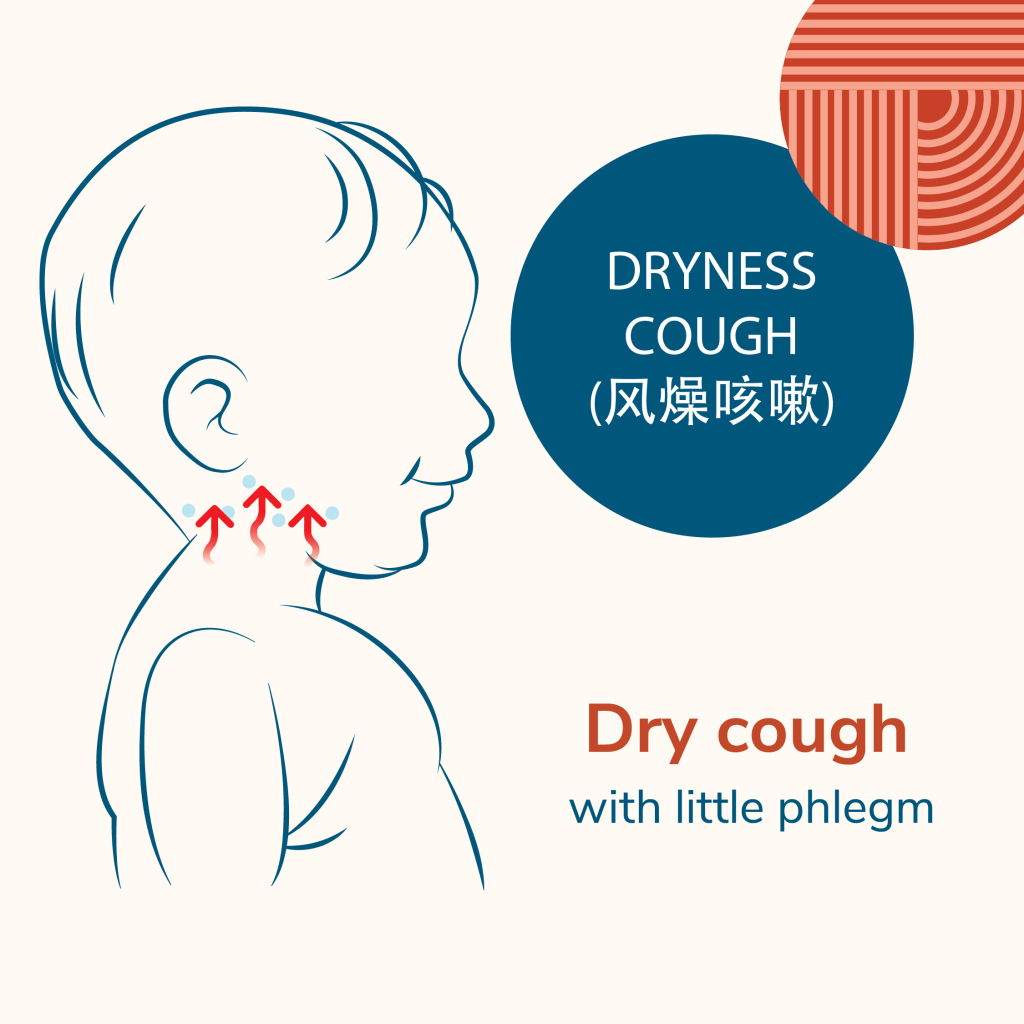
Dryness Cough (风燥咳嗽)
- Dry coughing with little phlegm
- Dry nose
- Warm body temperature
- Red tongue with pale yellow coating
Home Remedies for Parents
天突 (Tian Tu)
Acupoint Location: 天突 is located above the midpoint above two collar bones and above the sternum (the T-Shaped vertical bone between your collar bone).
How to massage: You can sit your child up and face you for you to find the acupoint easier. Use your thumb tip to knead gently for 2 mins. Take note that you should only use light and gentle pressure to avoid causing your child to feel uncomfortable and airway being blocked.
Benefit: Regulate Qi, Reduce phlegm, Wheezing shortness of breath, Reduce cough
定喘 (Ding Chuan)
Acupoint Location: 定喘 is the two acupoints located at two sides of the most prominent bone at the bottom of the neck, connected to the back.
How to massage: Let your child lie face down. Use your index and middle finger to form a V to gently massage in an up-down motion for 2 minutes.
Benefit: Expel ‘wind’, relieve cold, soothe lung and wheezing shortness of breath
肺俞 (Fei Shu)
Acupoint Location: 肺俞 is below 定喘 (Ding Chuan), located in between the inner scapula and 3rd Spinous Process. It might be difficult to locate the exact point. So you can attempt to massage the area that will stimulate the acupoint.
How to massage: Use thumbs kneed in circular, up-down and left-right motion for 2 mins each
Benefit: Stop cough, reduce phlegm, nourish the lungs
搓摩肋胁 (Cuo Mo Le Xie)
How to massage: Make your child sit up front or back facing you. The area that you can massage is the side of your child’s rib cage, and the front and back of the rib cage.Use your 4 fingers to gently stroke and rub in circular, vertical up-down and horizontal motion for 2 mins each.
Benefit: Relieve and loosen muscles around the rib cage, increase lung capacity
Muscles tensed up when you cough, and your child will feel stuffy and restricted at the lung especially during breathing (胸闷)

